
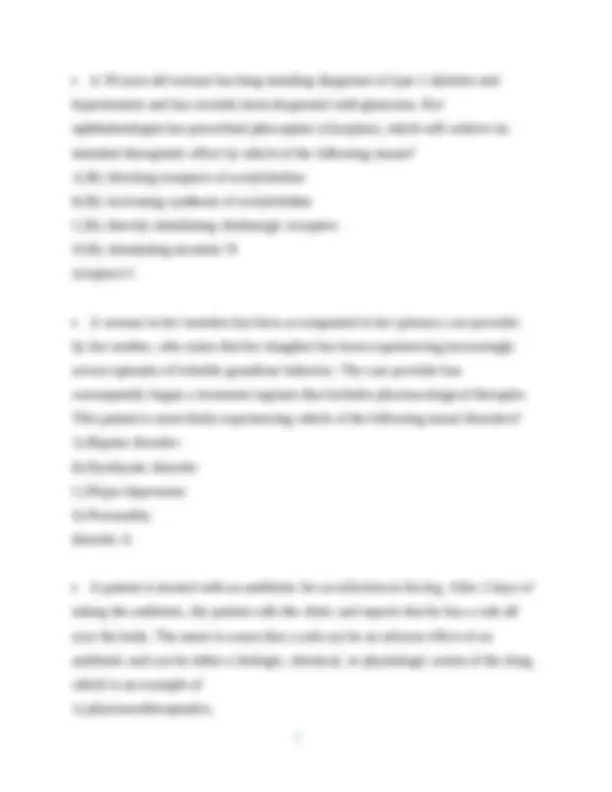
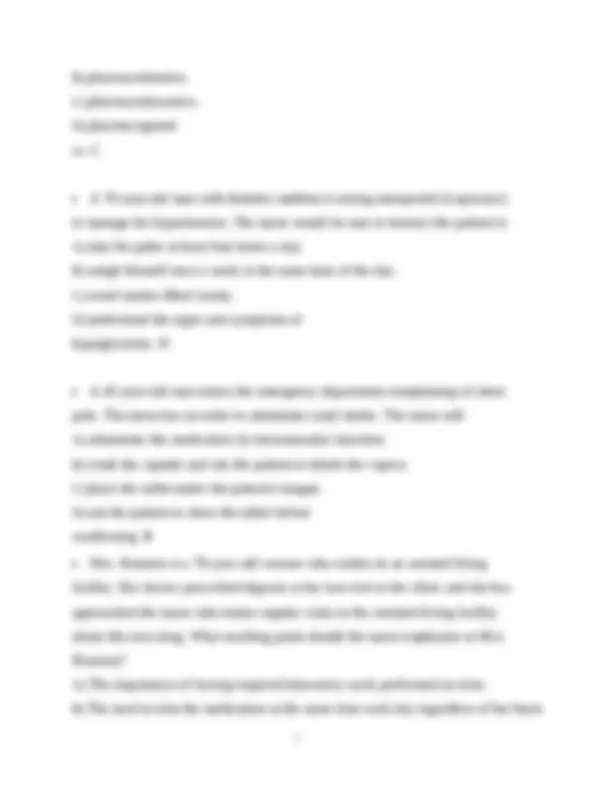
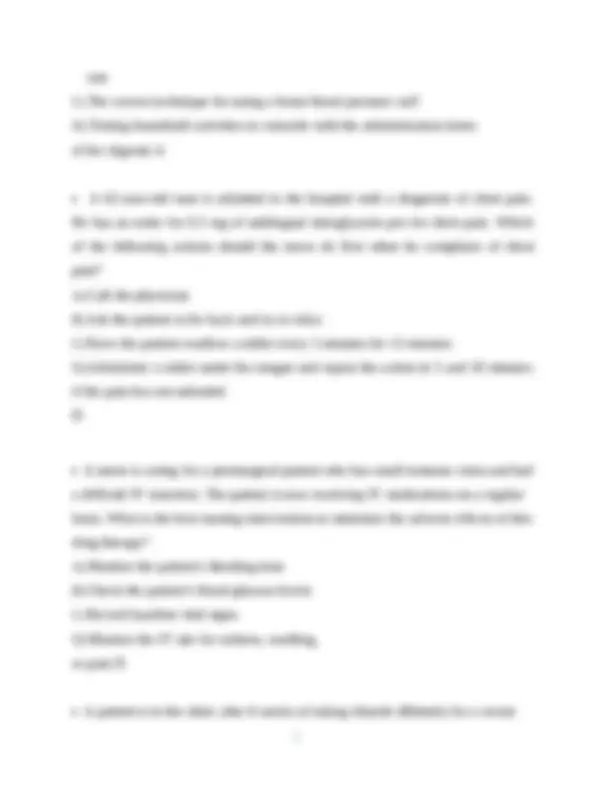
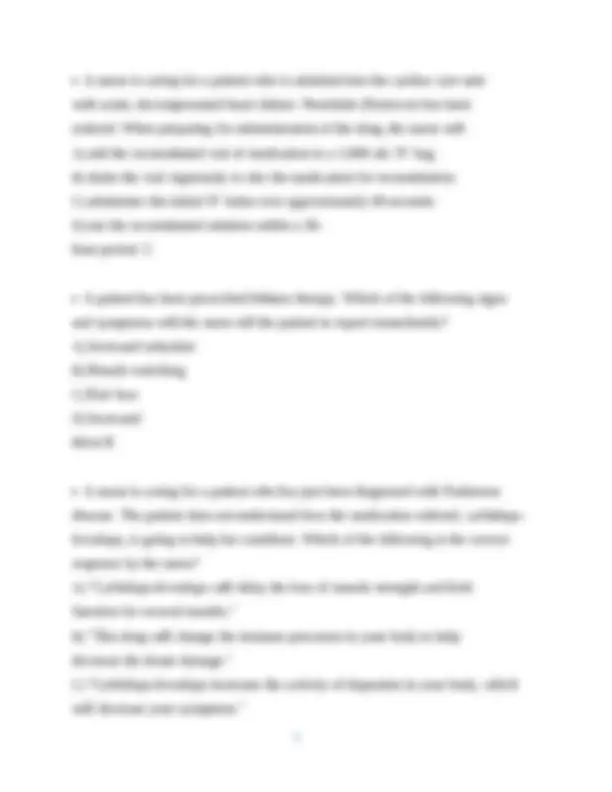
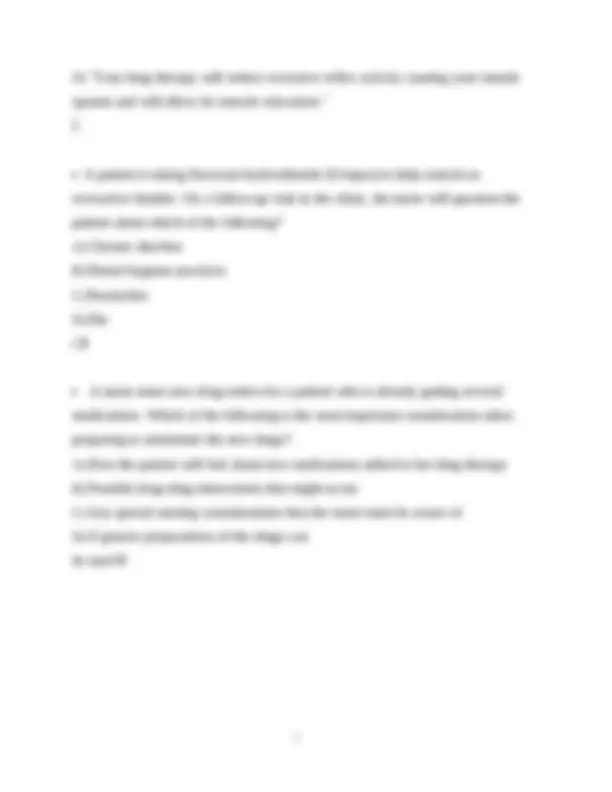
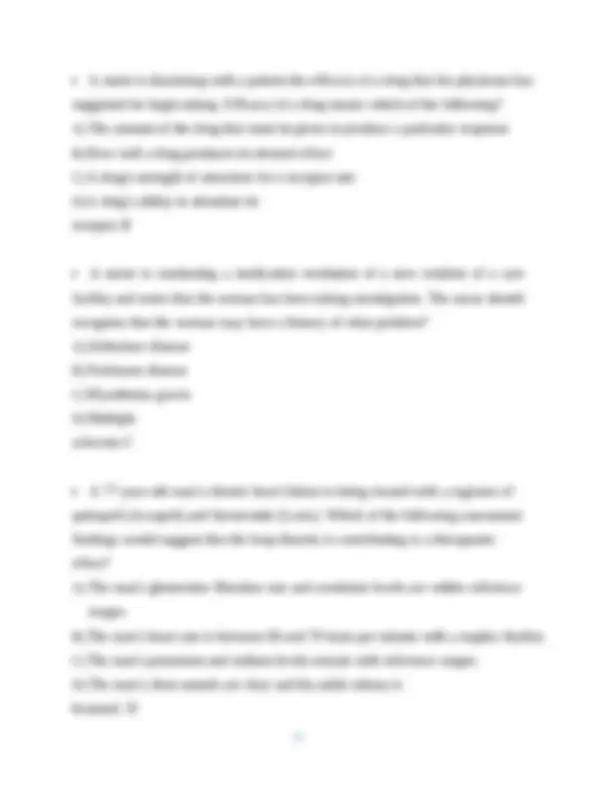
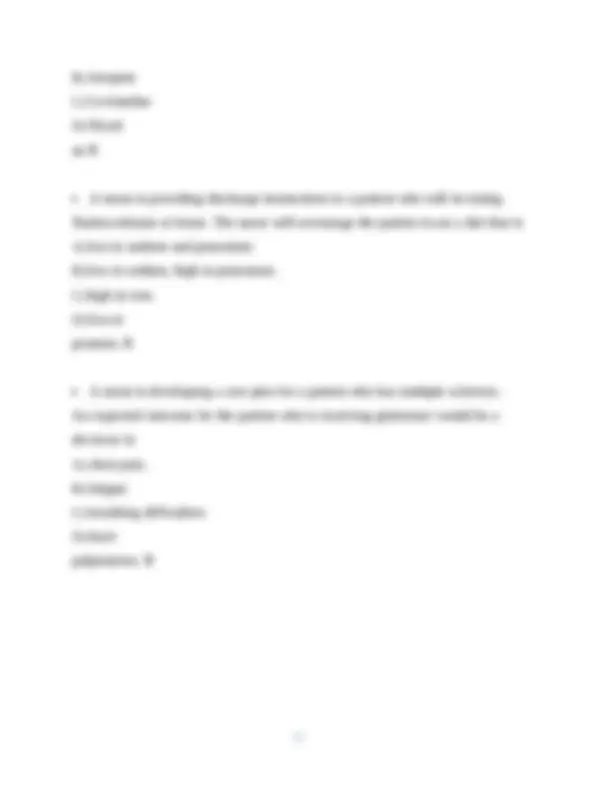
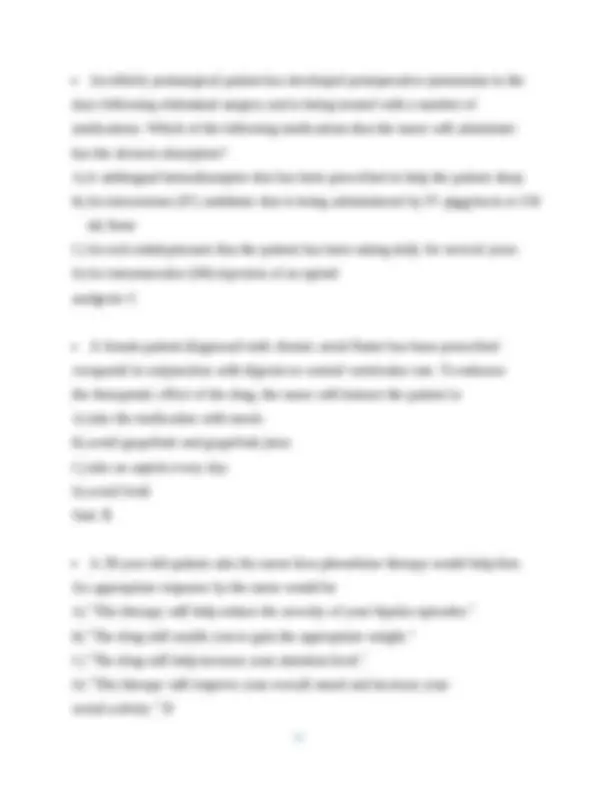
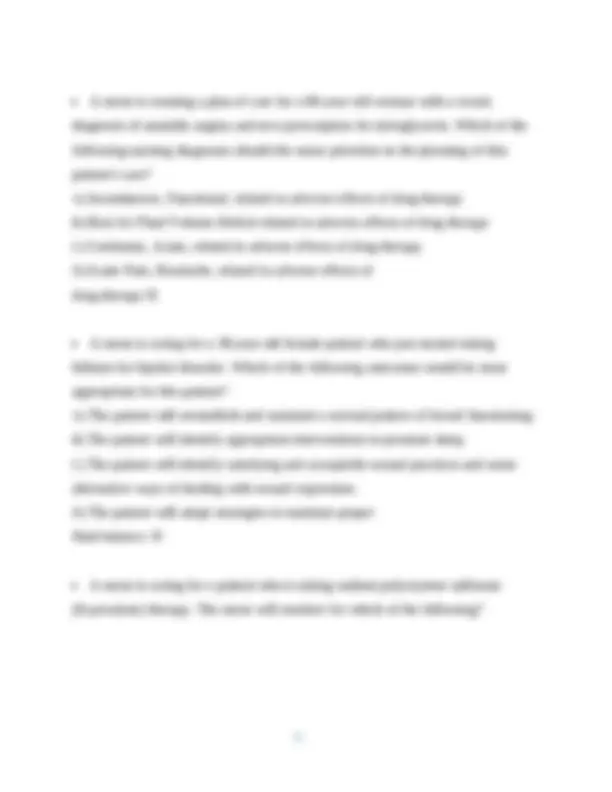
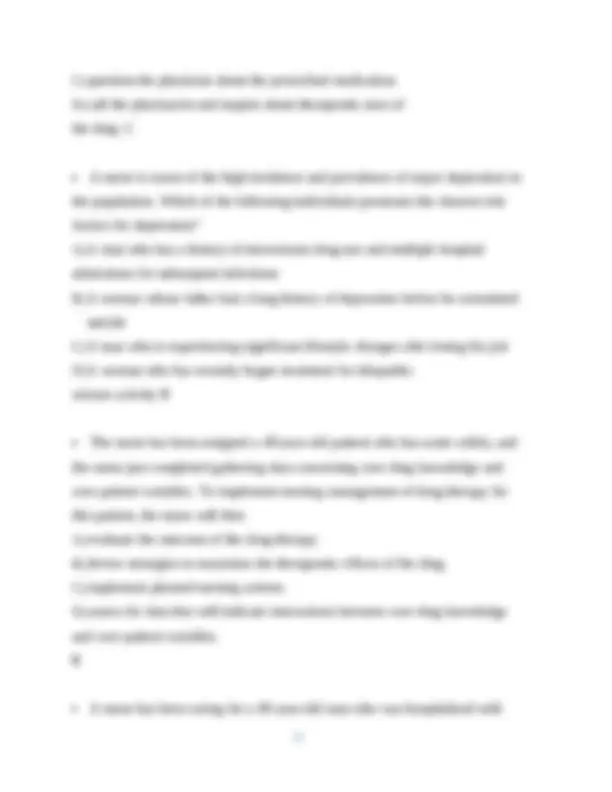
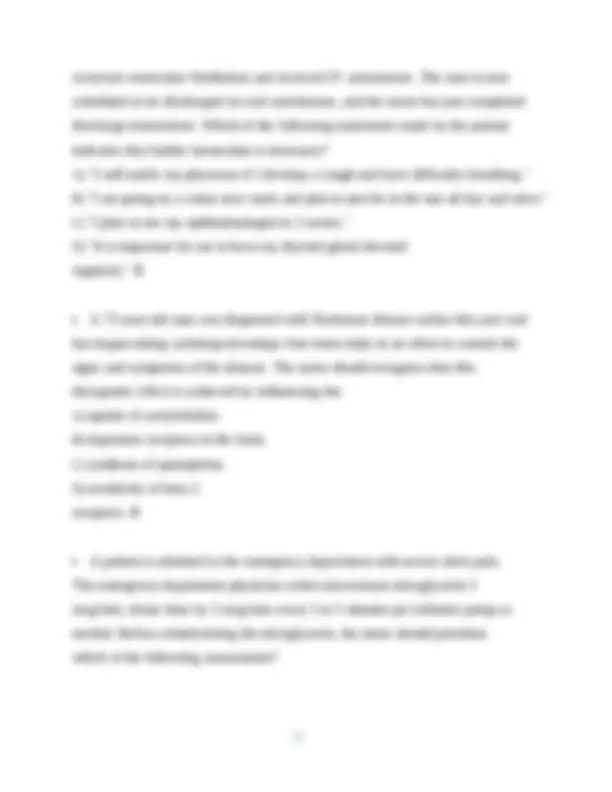
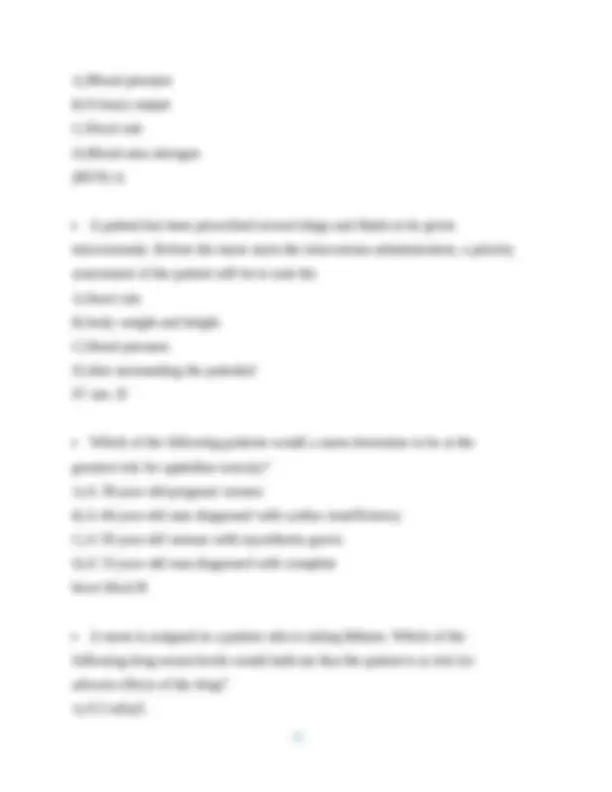
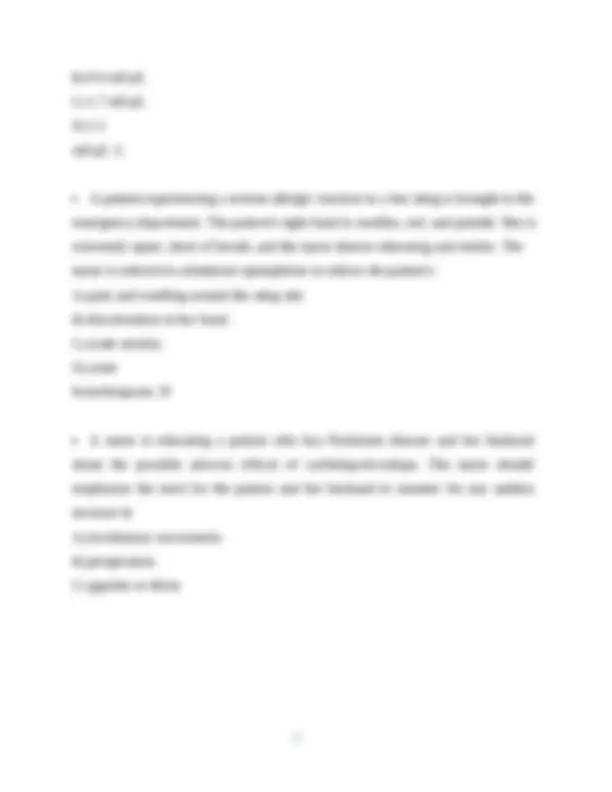
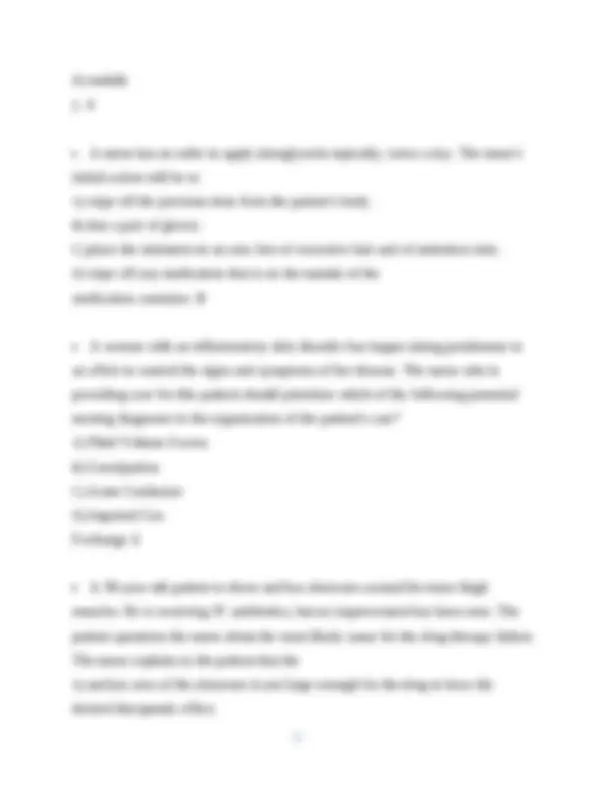
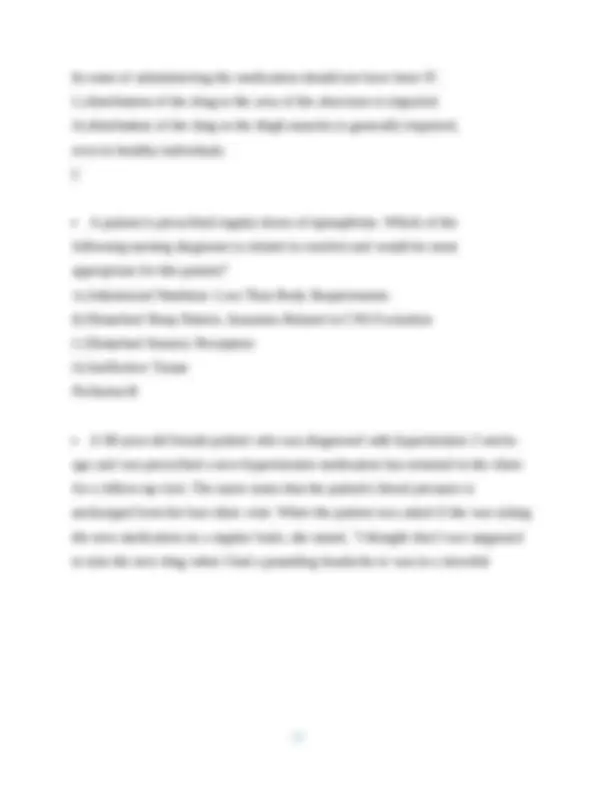
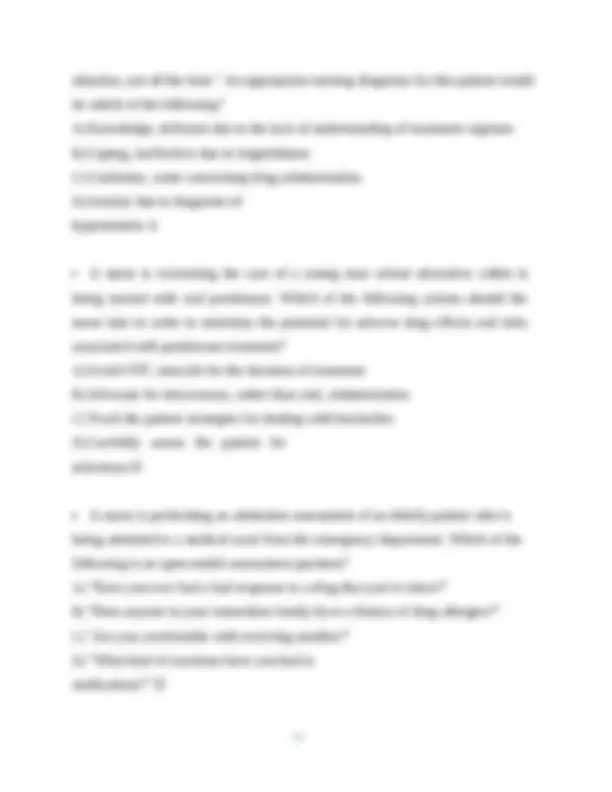
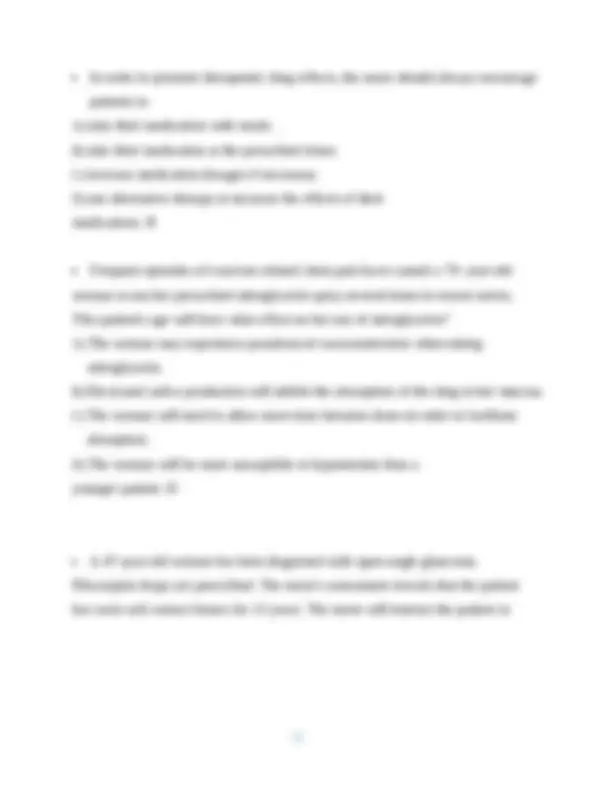
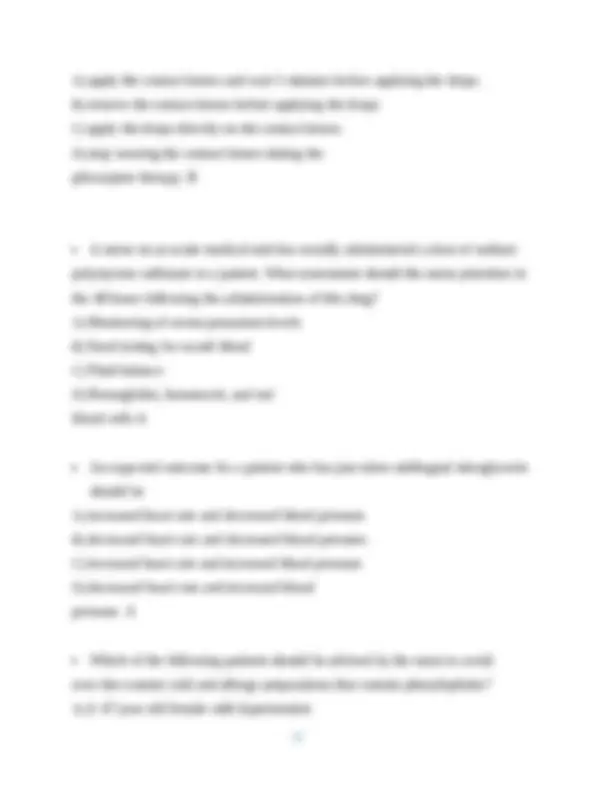
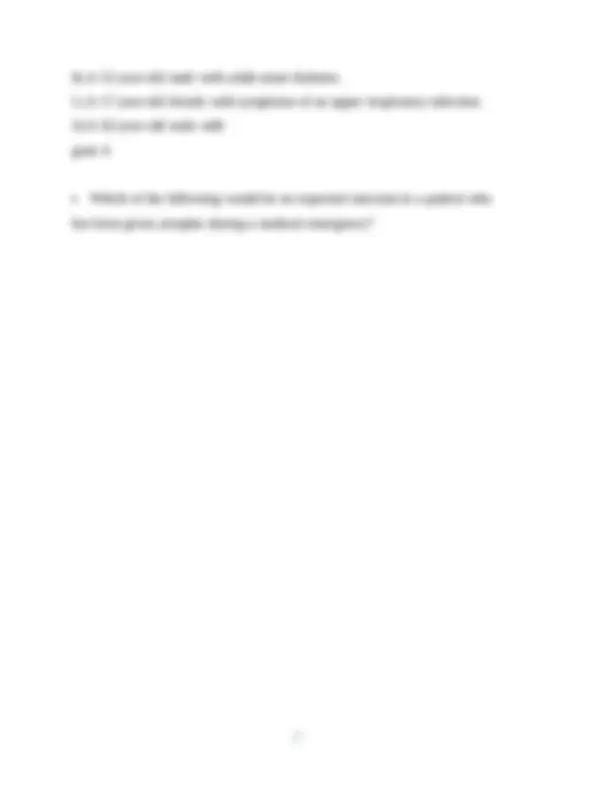
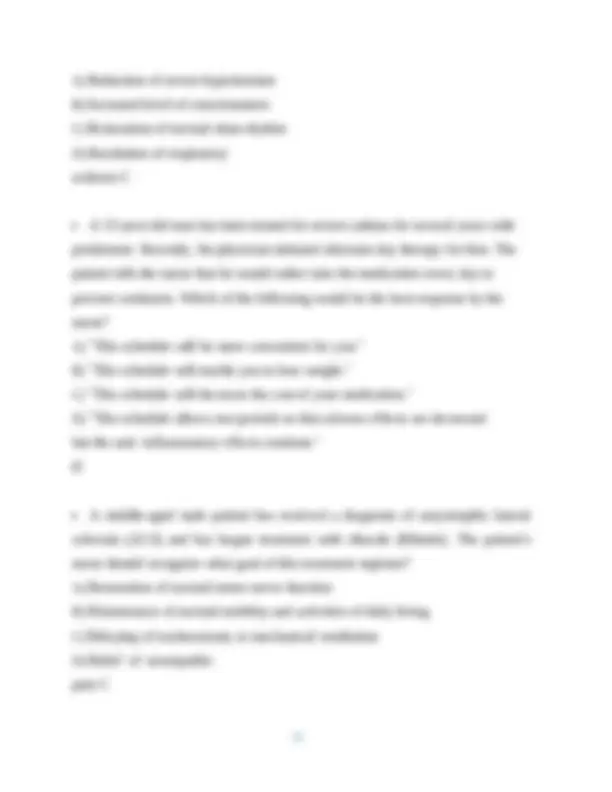
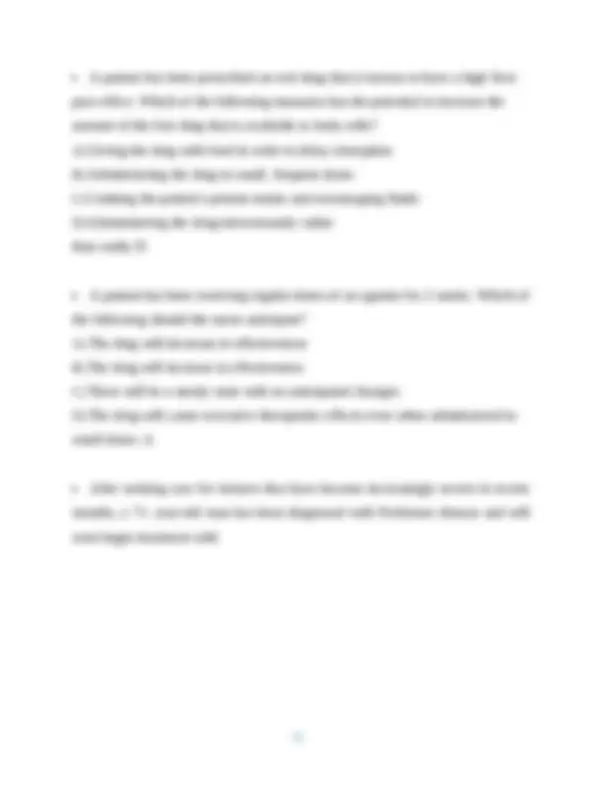
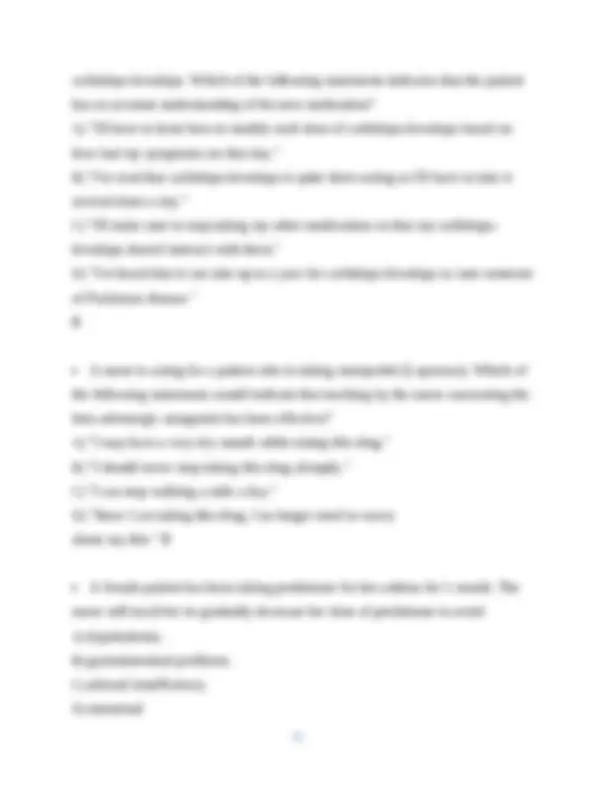
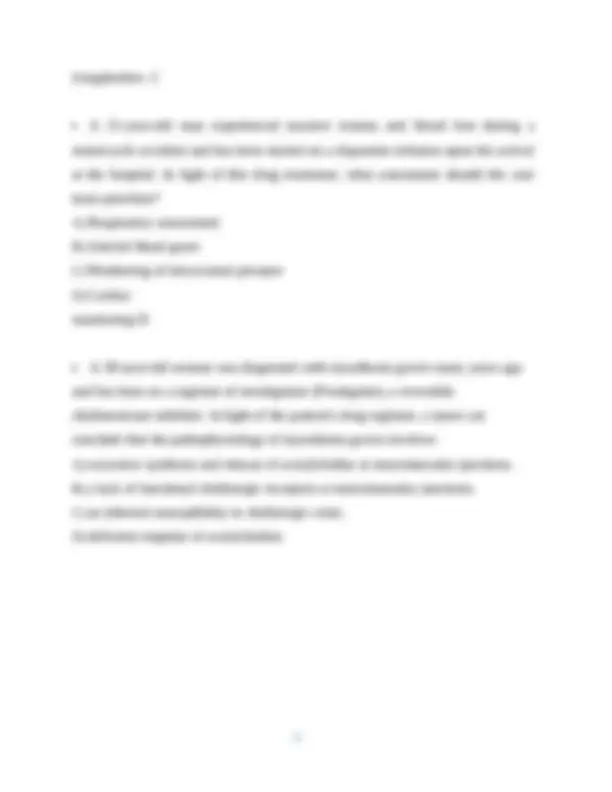
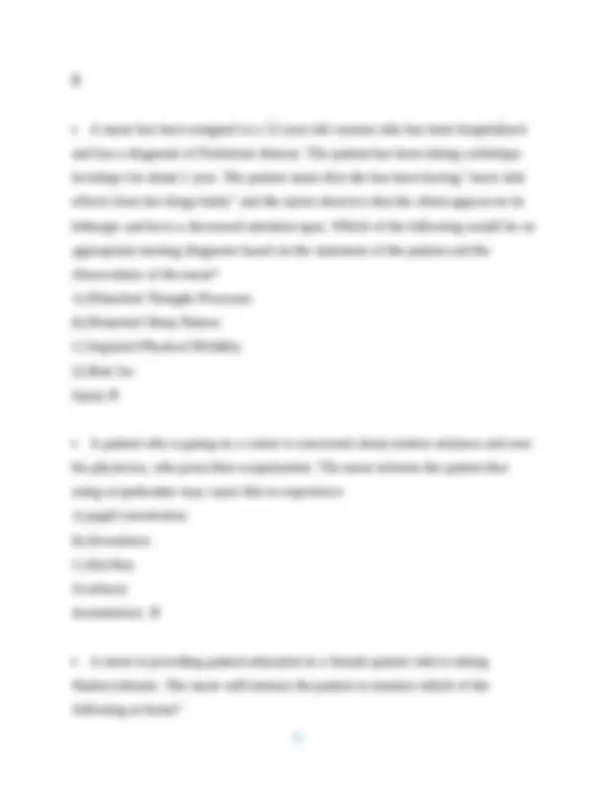
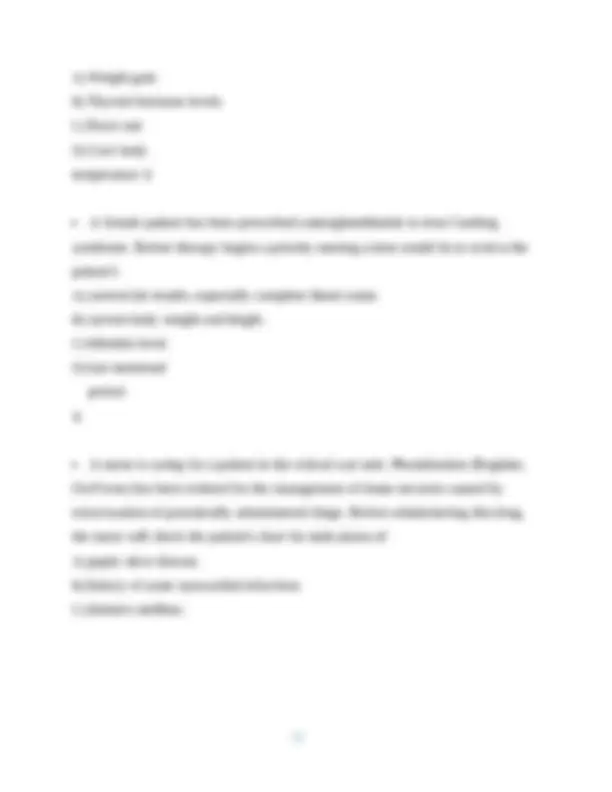
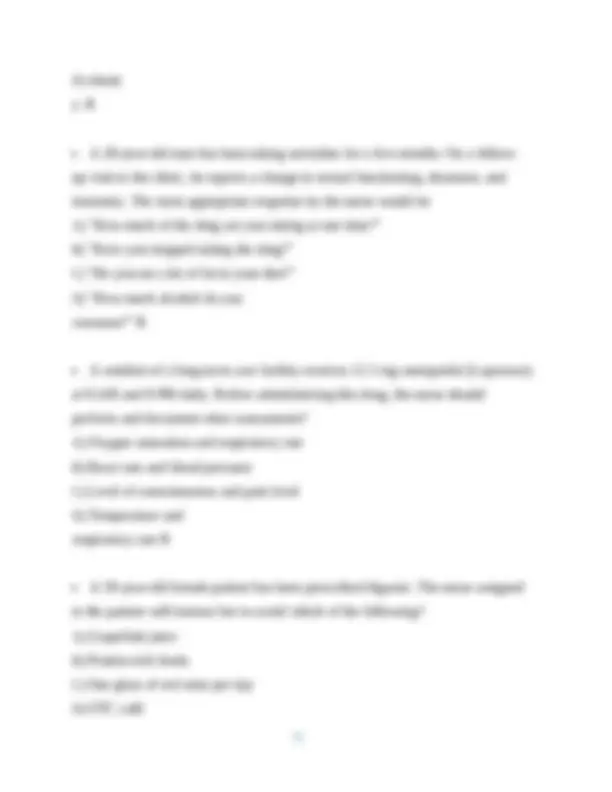
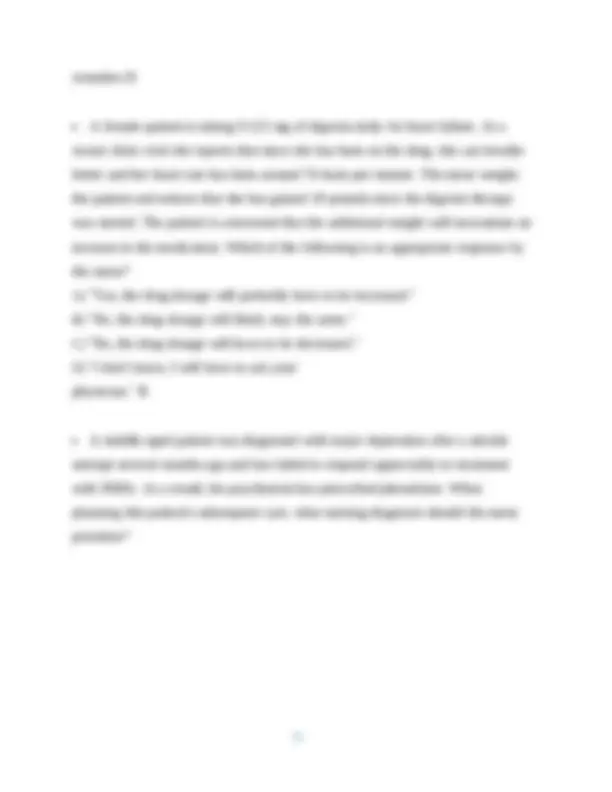
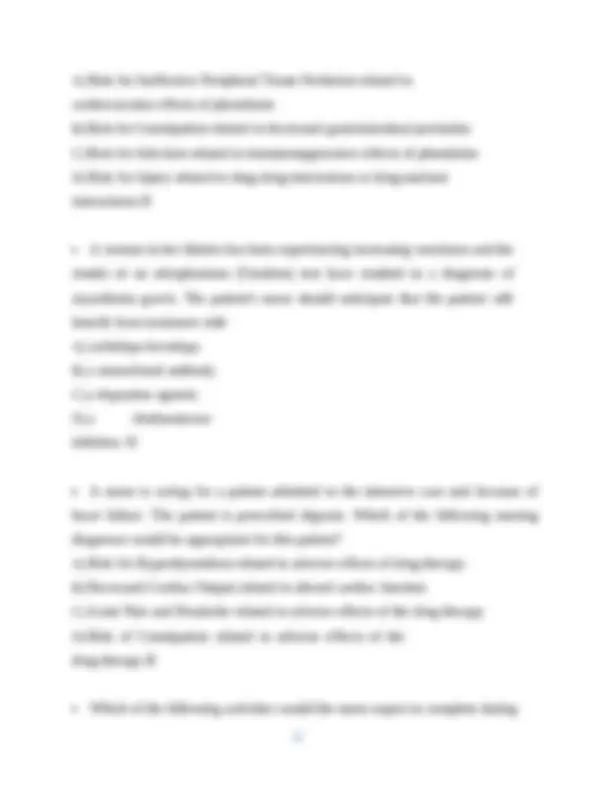
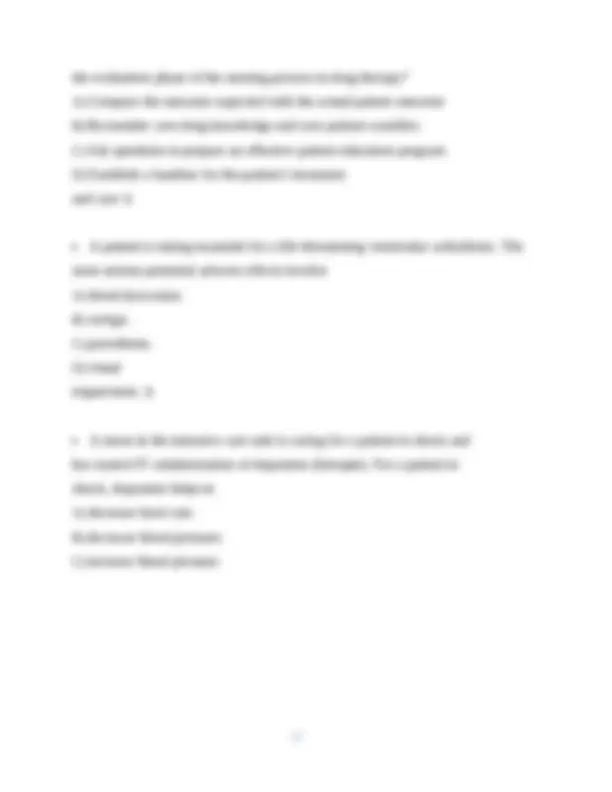
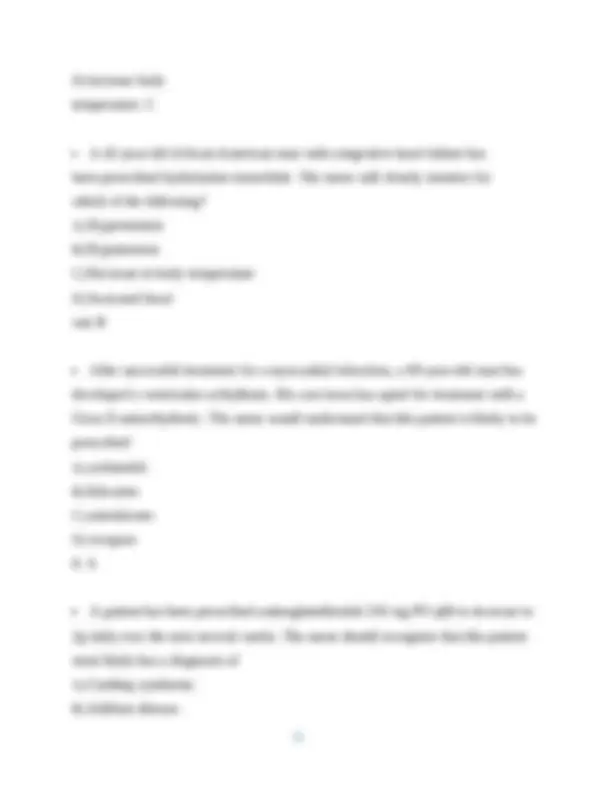
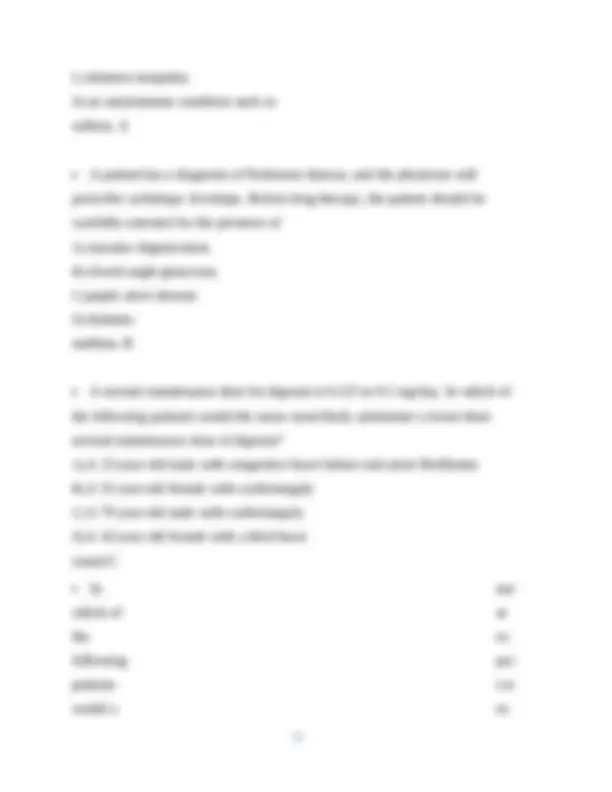
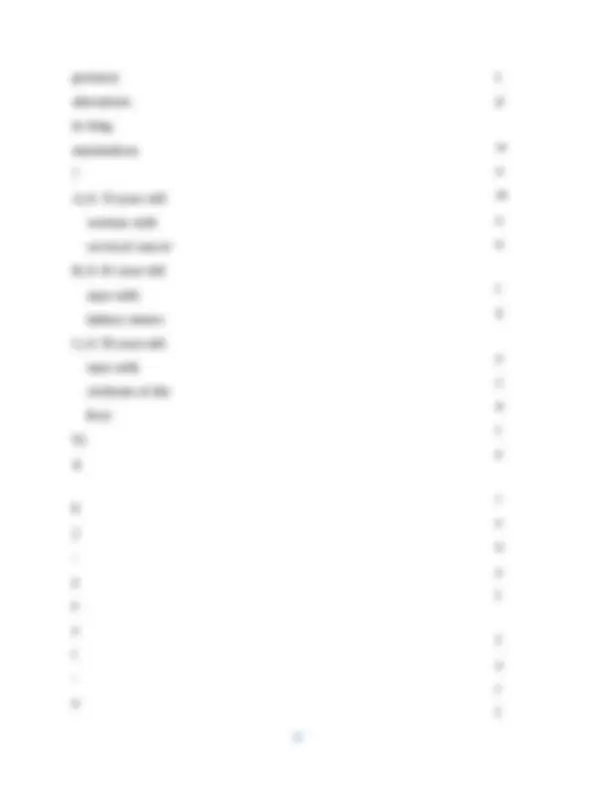
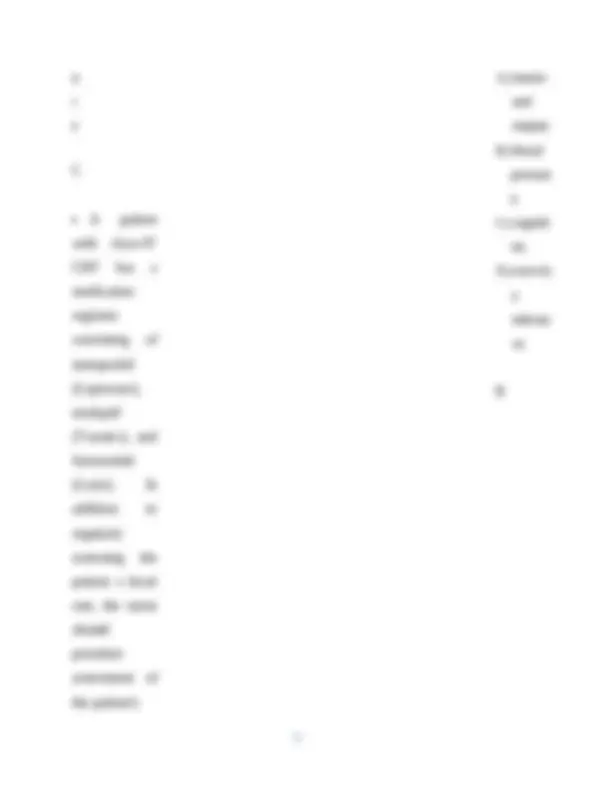
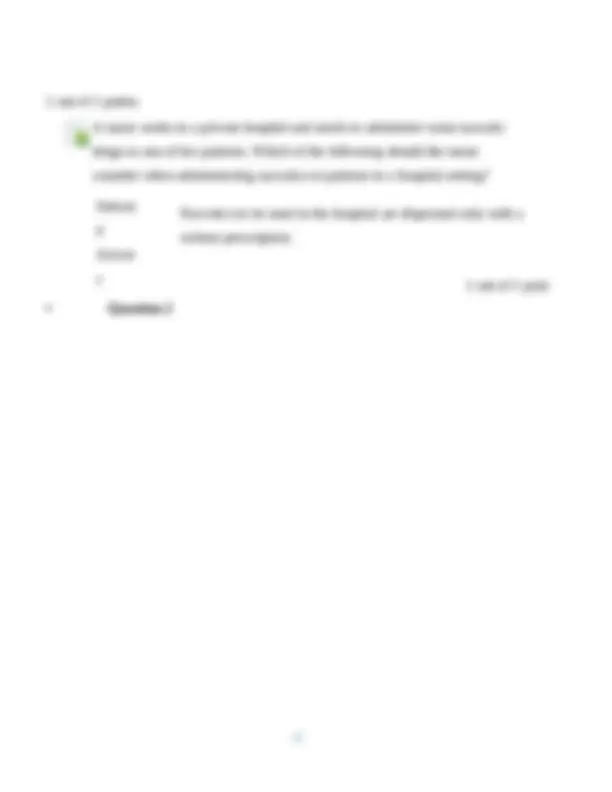
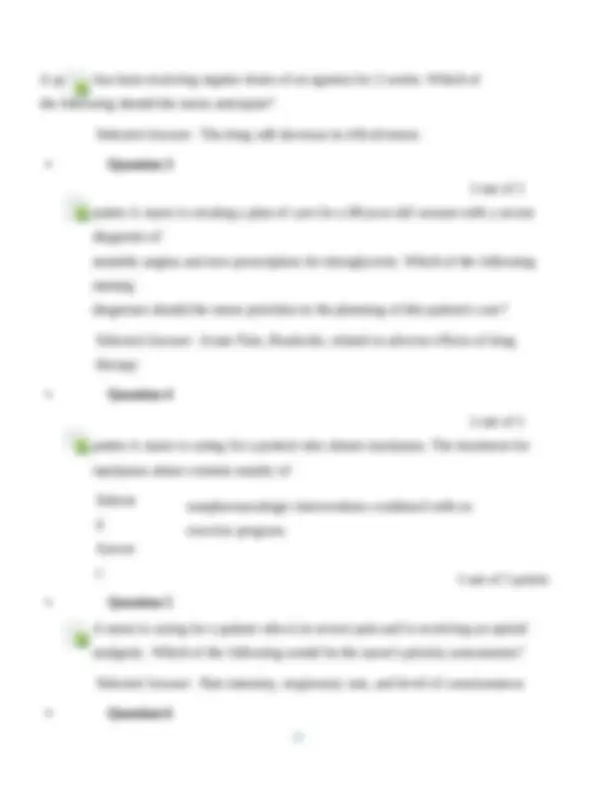
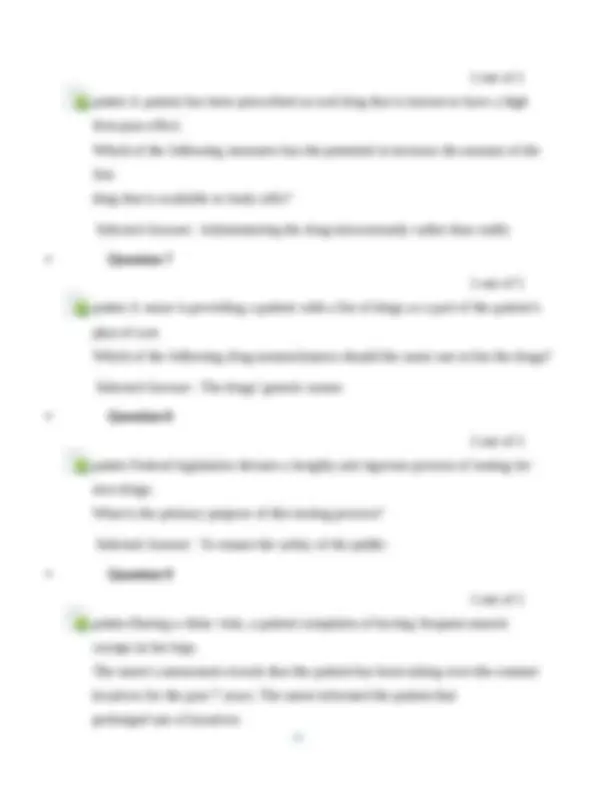
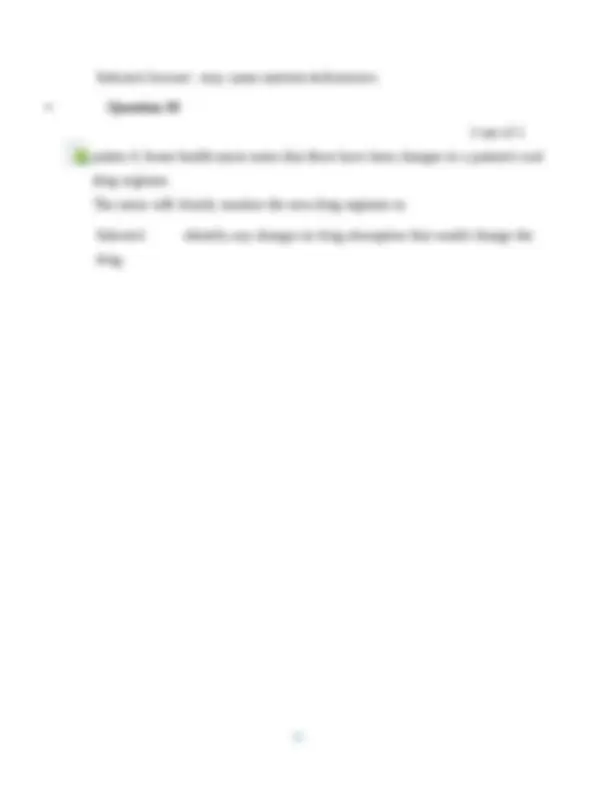
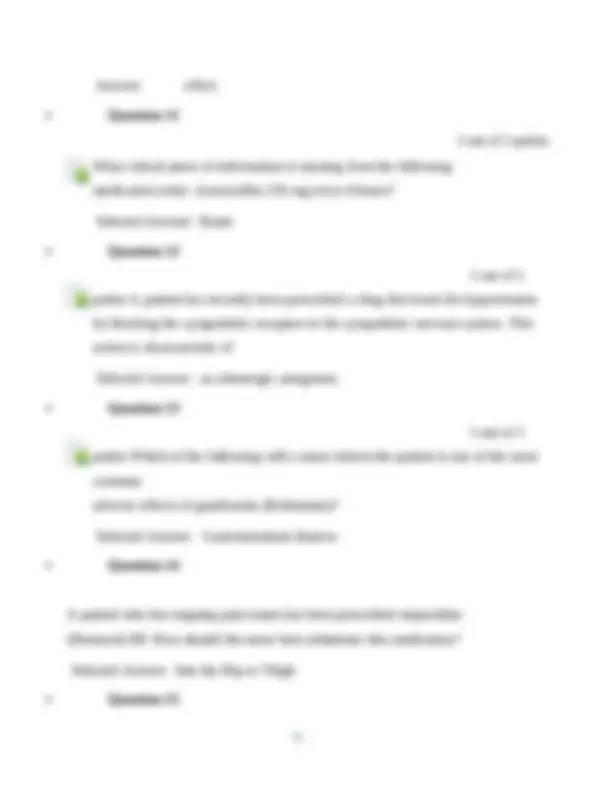
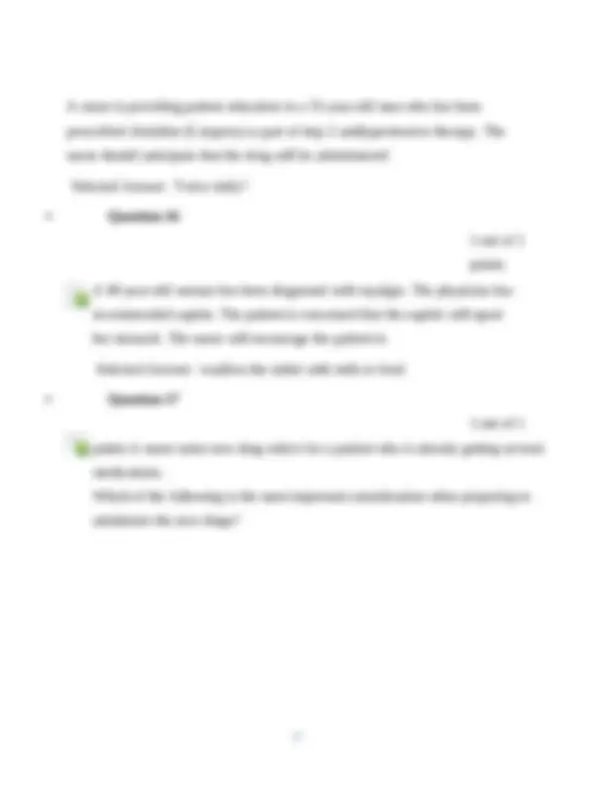
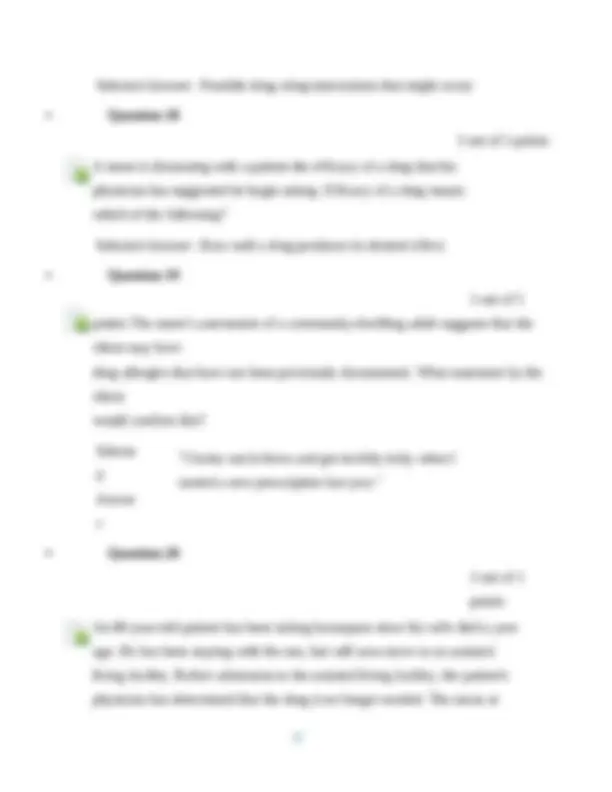
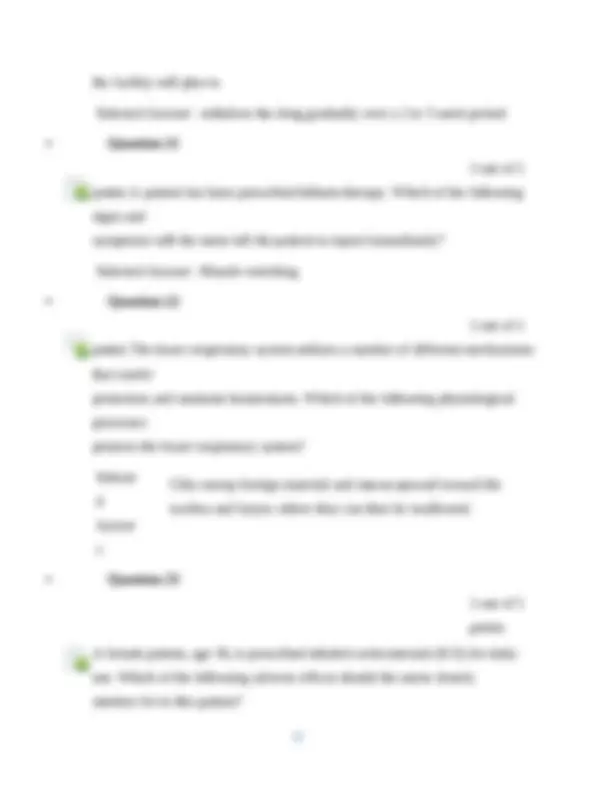

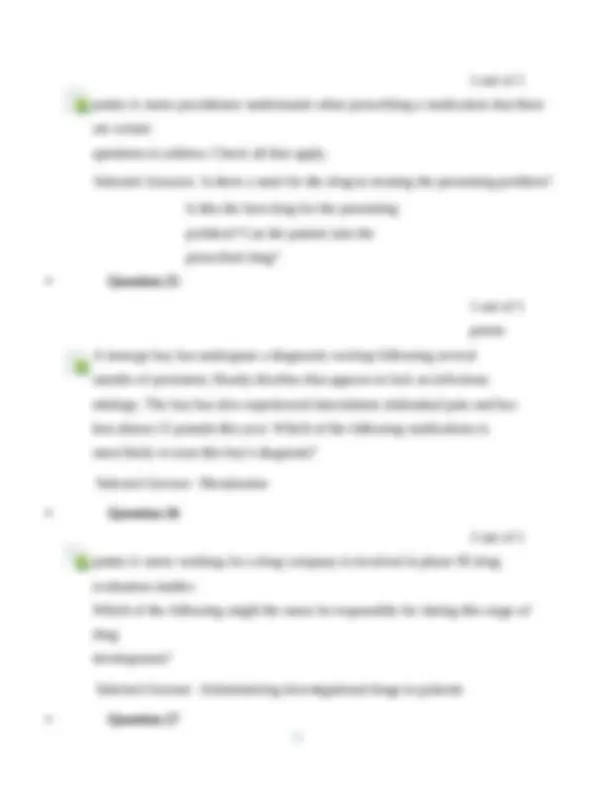
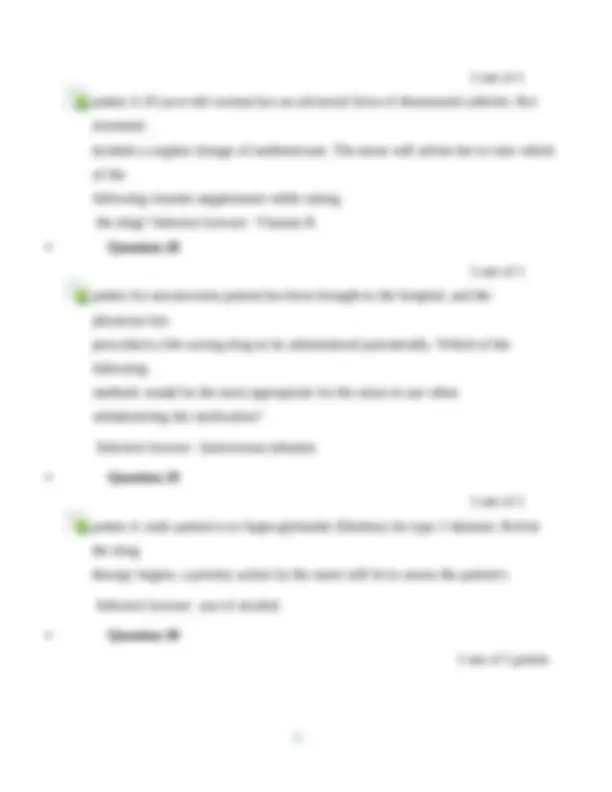
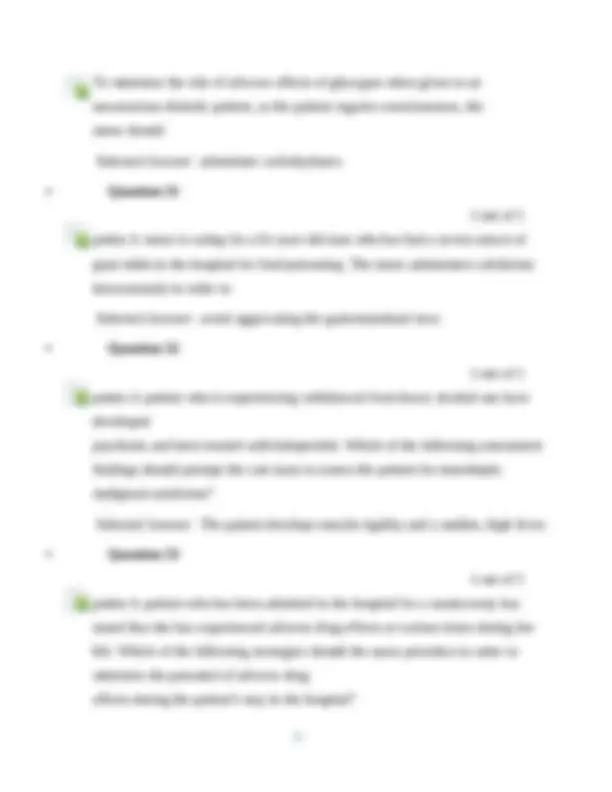
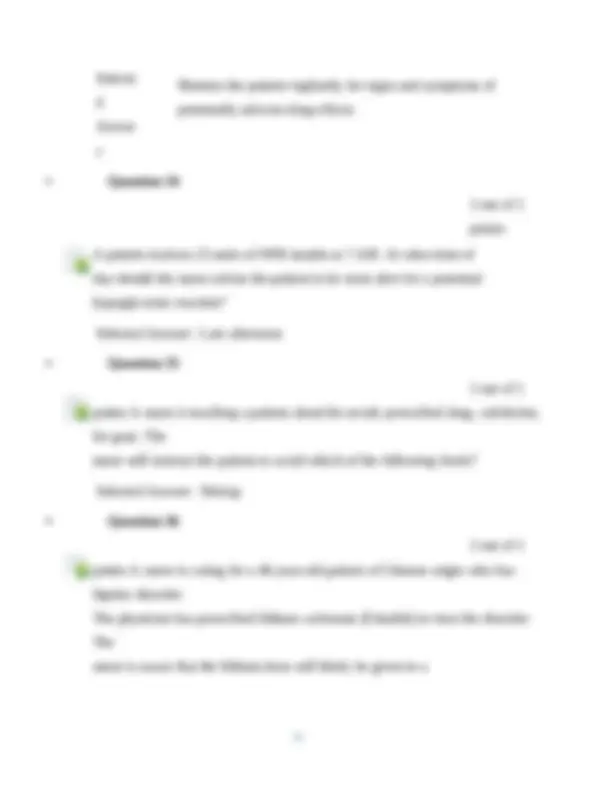
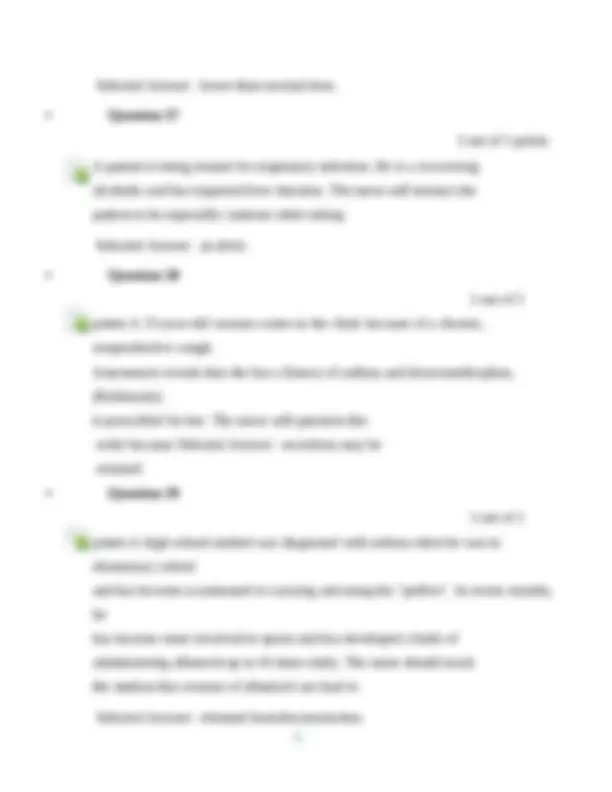
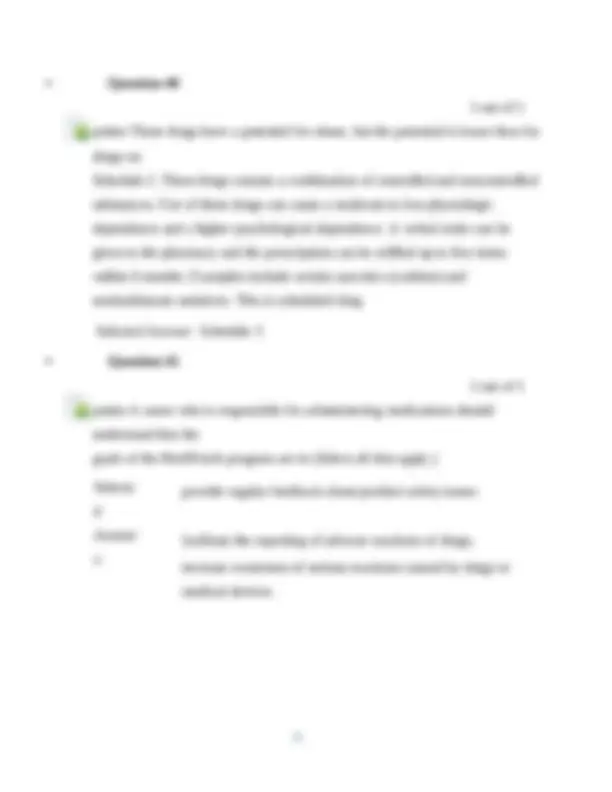
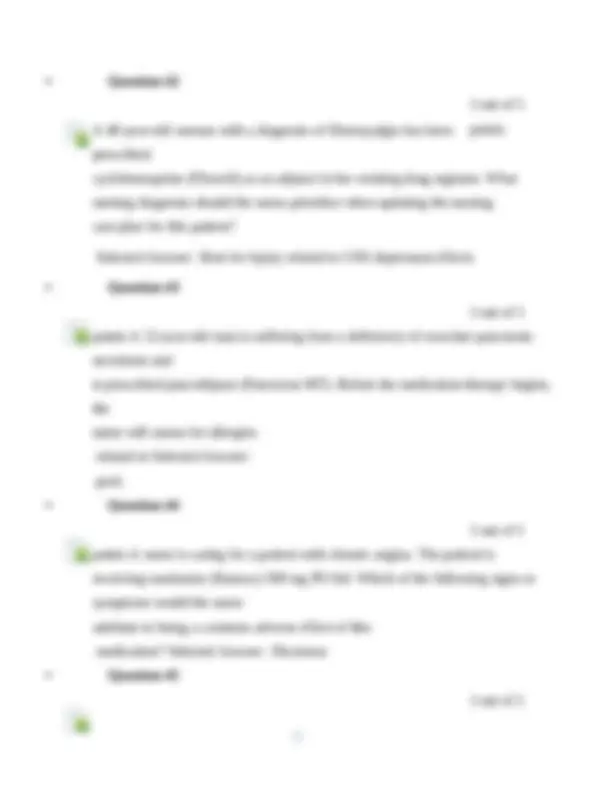
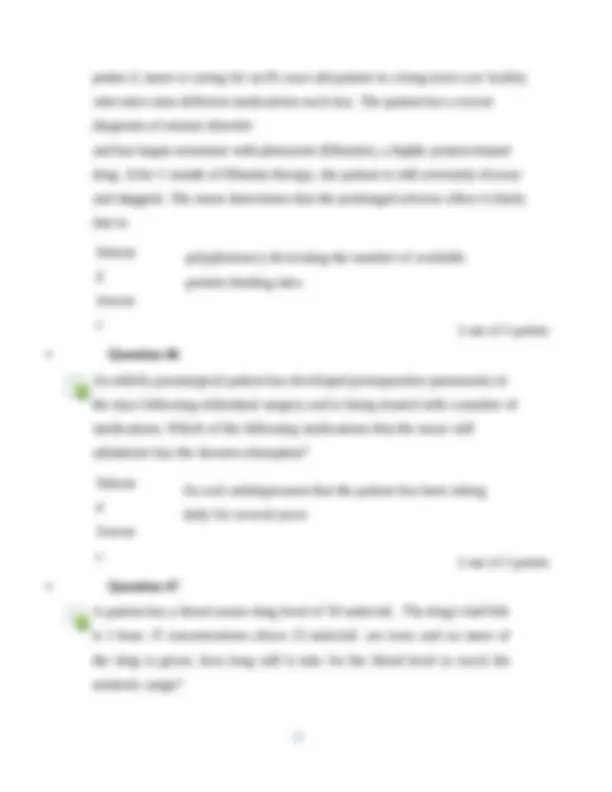
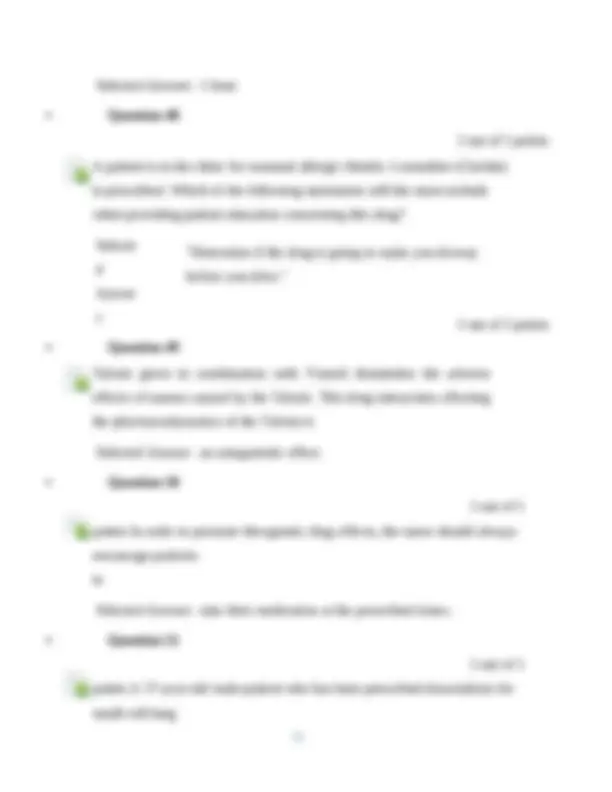
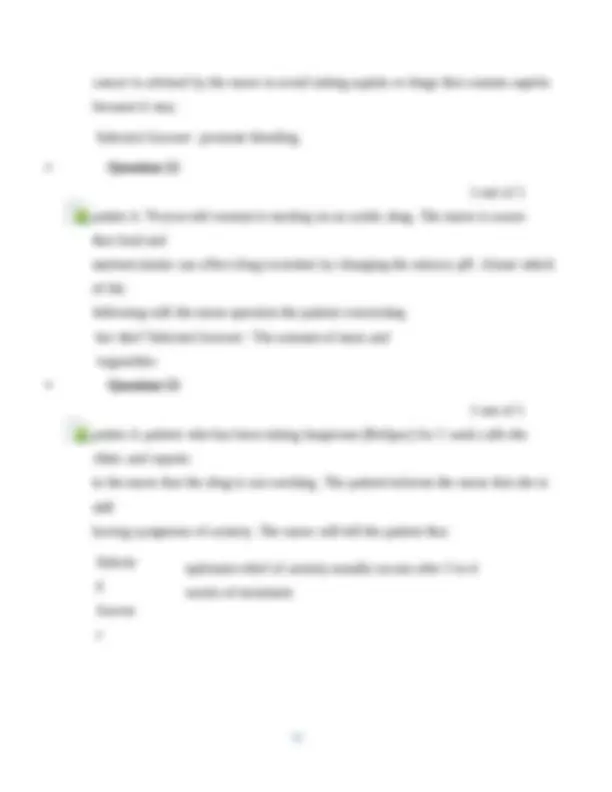
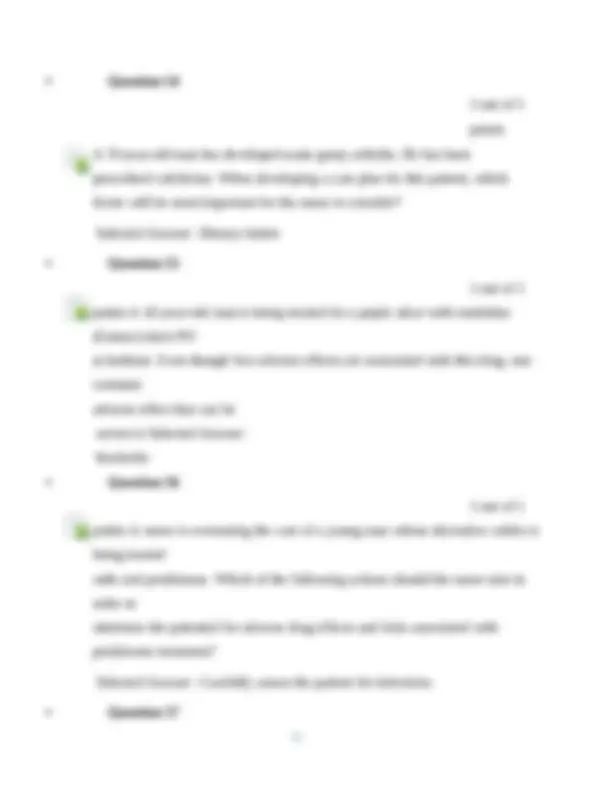
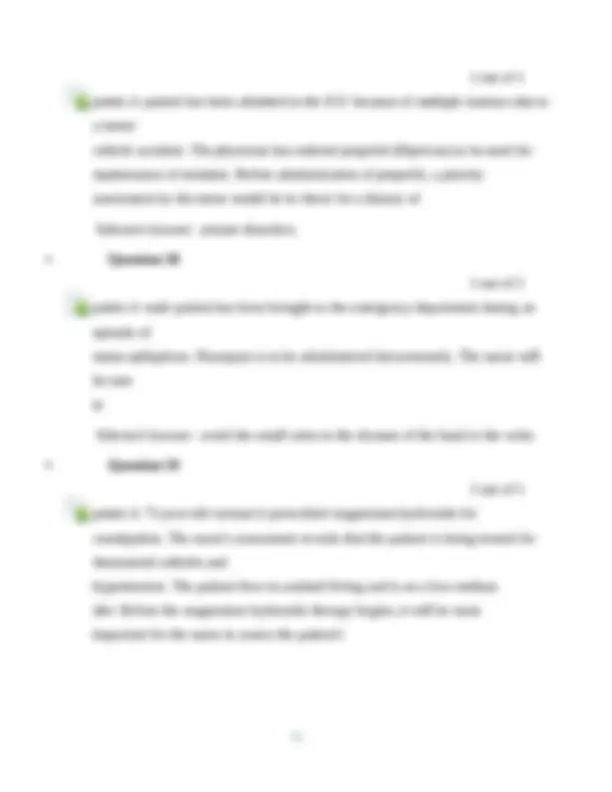
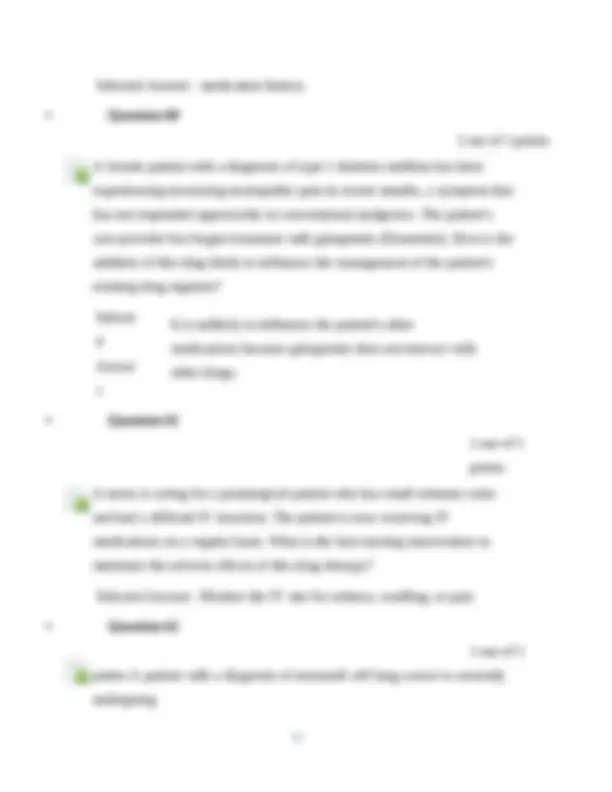
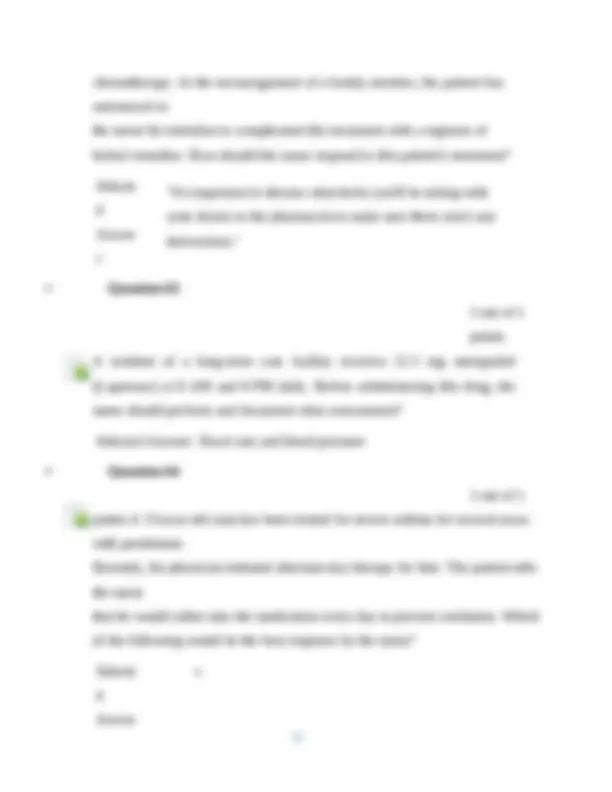

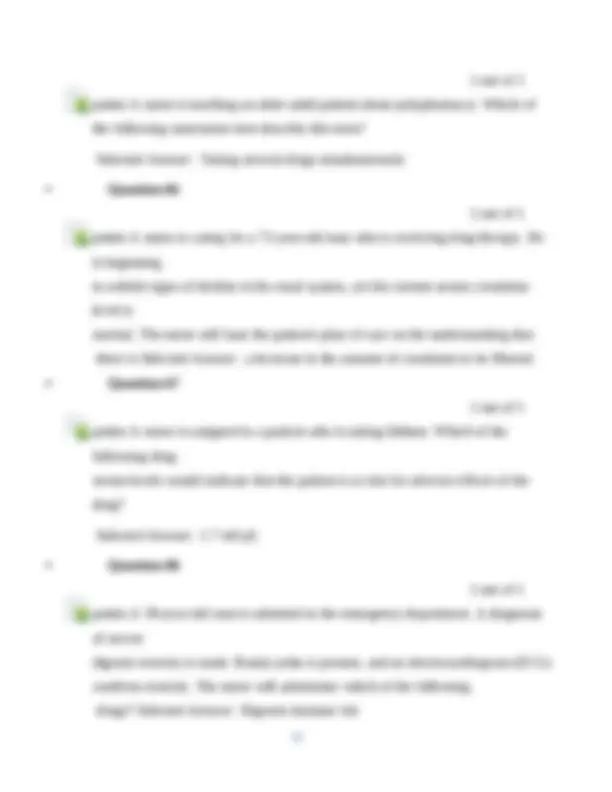
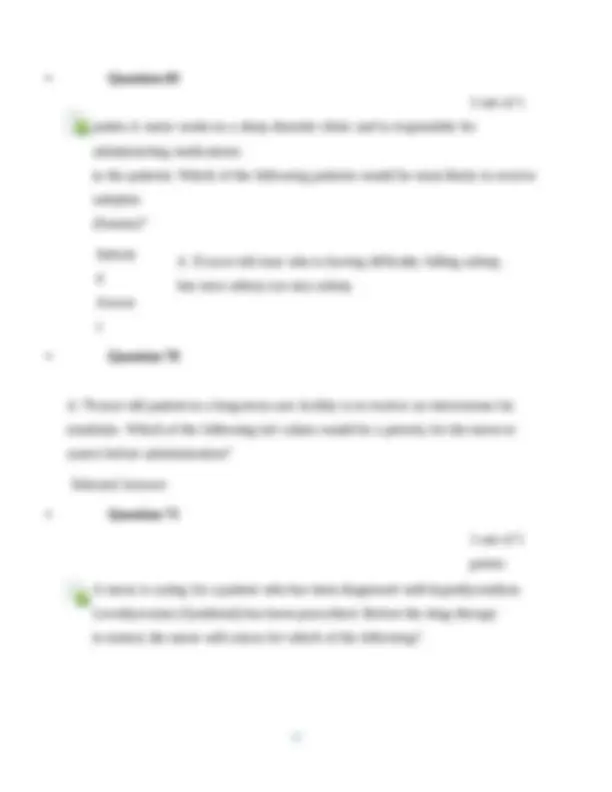
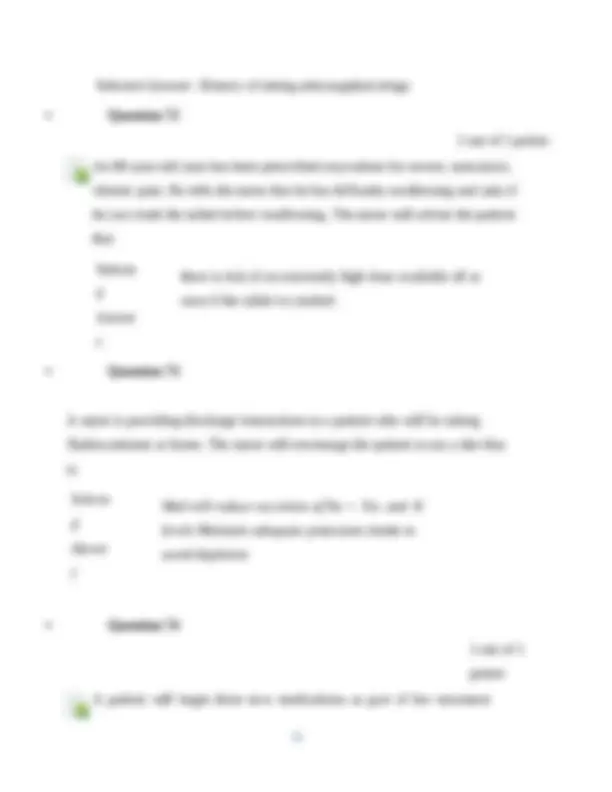
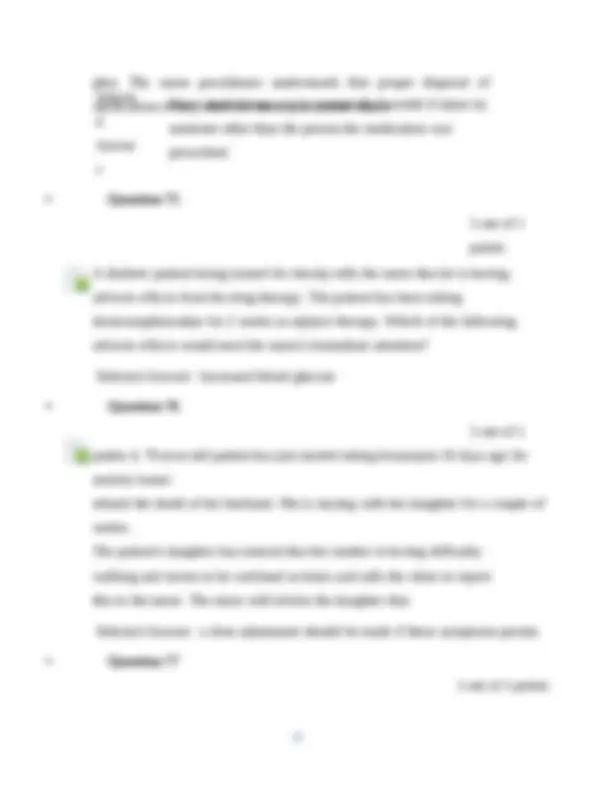

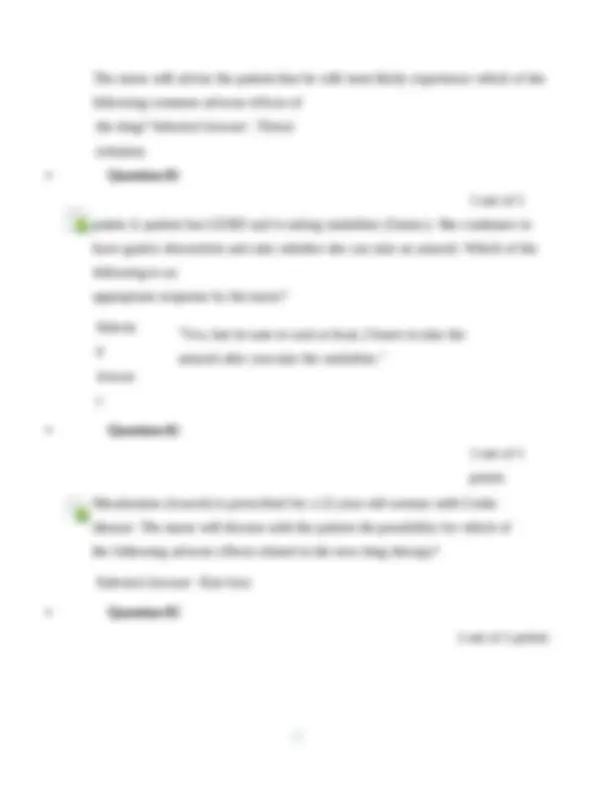
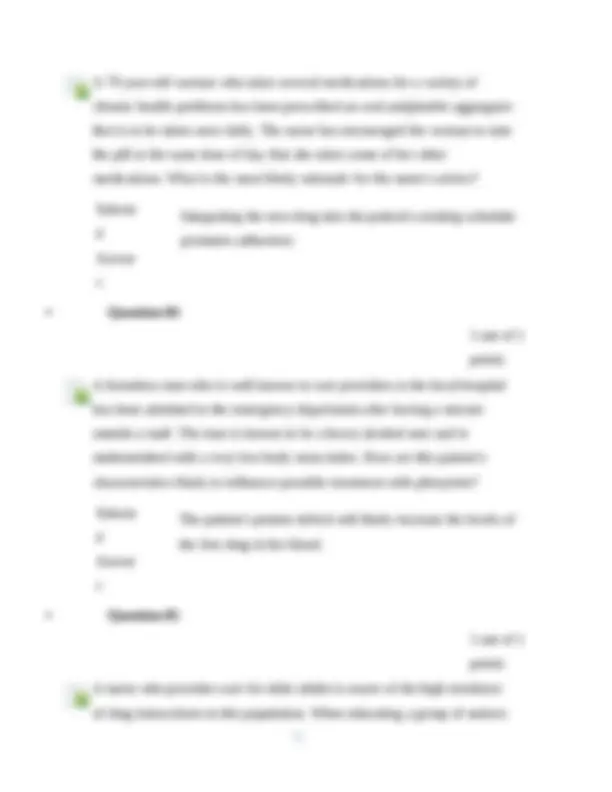
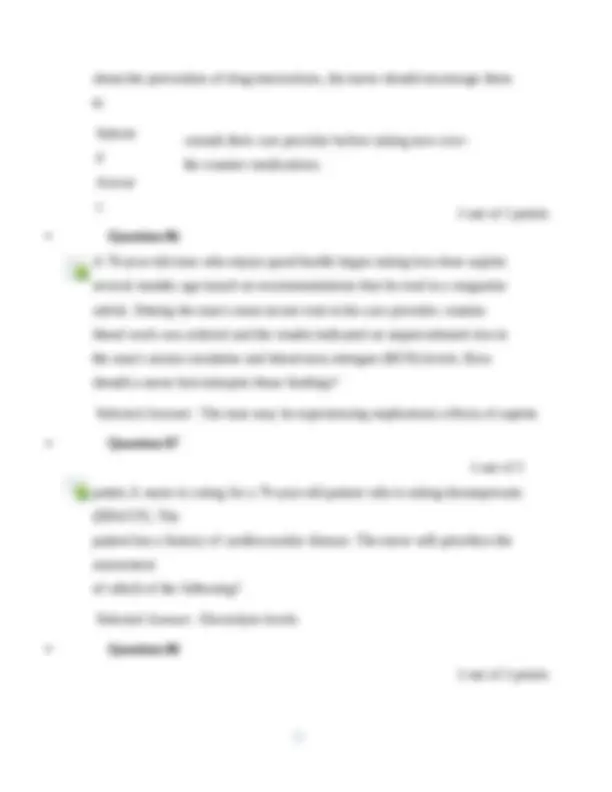
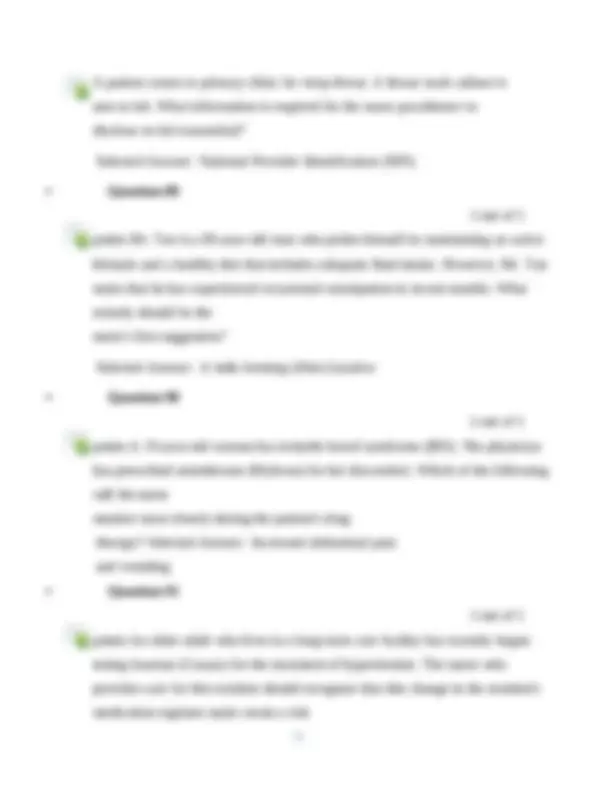
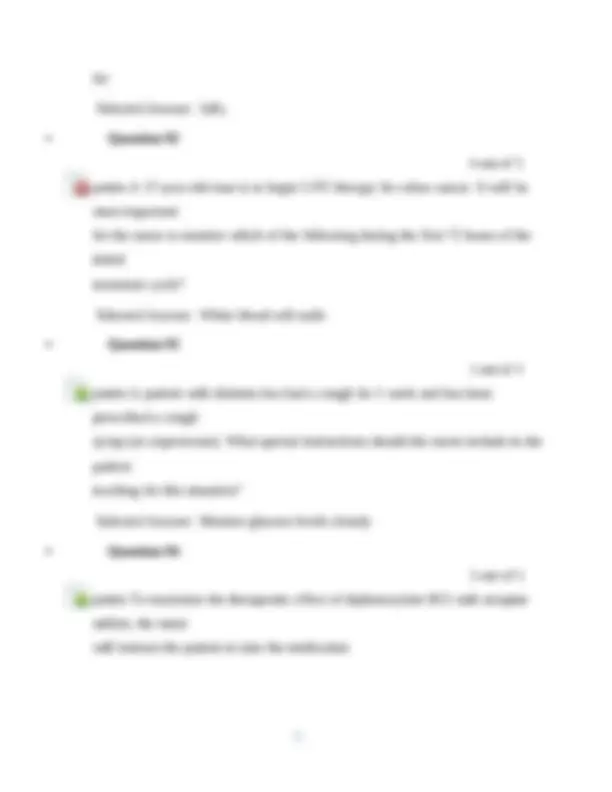
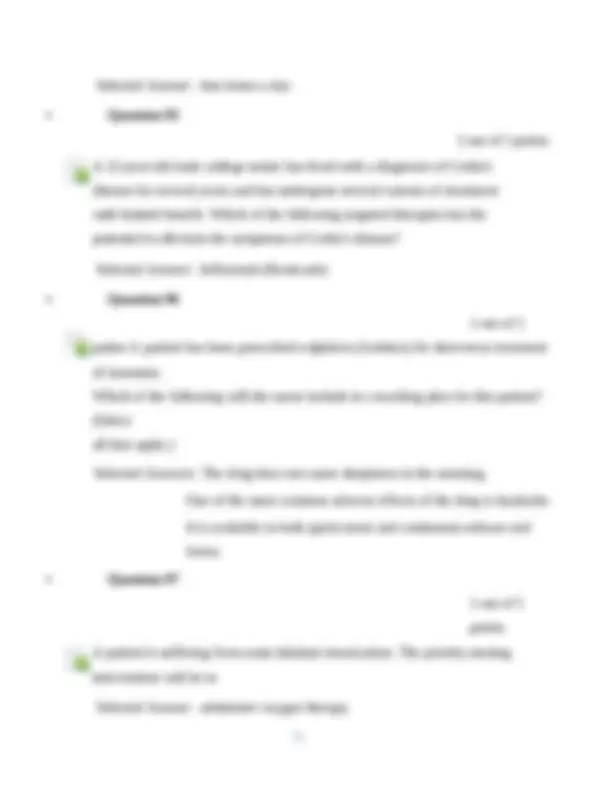
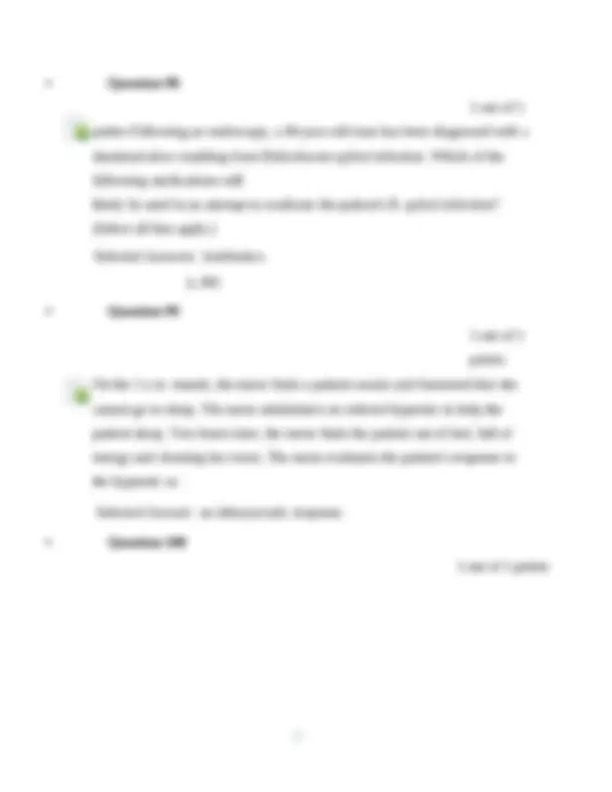
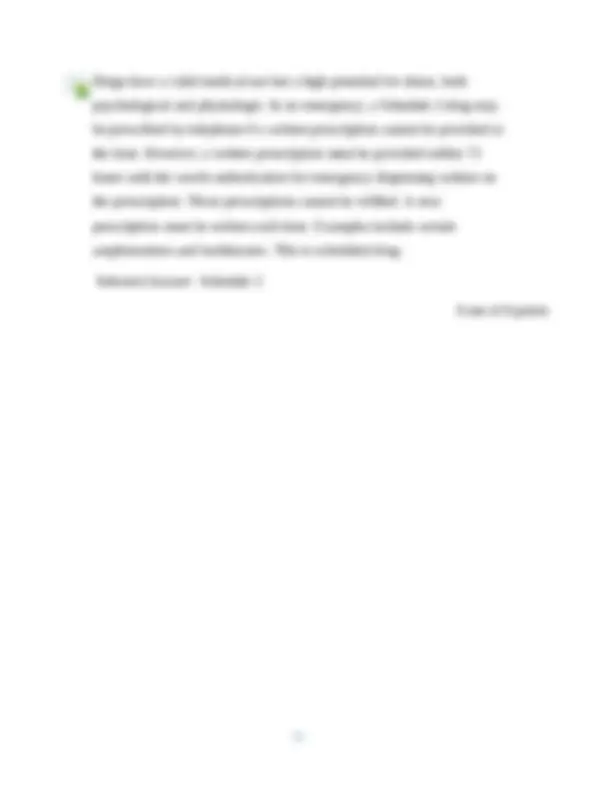


Study with the several resources on Docsity

Earn points by helping other students or get them with a premium plan


Prepare for your exams
Study with the several resources on Docsity

Earn points to download
Earn points by helping other students or get them with a premium plan
Community
Ask the community for help and clear up your study doubts
Discover the best universities in your country according to Docsity users
Free resources
Download our free guides on studying techniques, anxiety management strategies, and thesis advice from Docsity tutors
A series of exam questions and answers related to nursing care. The questions cover a range of topics, including medication administration, patient assessment, and contraindications for certain treatments. intended to help nursing students prepare for exams and assess their knowledge of nursing care.
Typology: Exams
1 / 78

This page cannot be seen from the preview
Don't miss anything!







































































A nurse who provides care on an acute medicine unit has frequently recommended the use of nicotine replacement gum for patients who express a willingness to quit smoking during their admission or following their discharge. For which of the following patients would nicotine gum be contraindicated? A) A patient who received treatment for kidney failure due to an overdose of acetaminophen B) A patient whose pulmonary embolism was treated with a heparin infusion C) A patient with a history of angina who experienced a non-ST wave myocardial infarction D) A patient whose stage III pressure ulcer required intravenous antibiotics and a vacuum dressing C A patient calls the clinic and reports that he is having chest pain. The patient states that "I'm scared that I am going to die and I've been pacing up and down my driveway." After calming the patient, the initial instruction by the nurse would be to A) ask the patient to call 911 and wait outside for the ambulance to arrive. B) ask the patient to place a nitroglycerin tablet under his tongue immediately. C) have the patient take his pulse for 1 minute. D) have the patient go into his house and sit or lie down. D
Constipation is a major problem in patients with amyotrophic lateral sclerosis (ALS). The nurse will educate the patient and family to A) choose a laxative at the local drug store. B) use prune juice only. C) consult their physician before purchasing a laxative. D) walk at least 500 yards a day. C A nurse has been assigned to care for a 52-year-old attorney who has hypertension and peptic ulcer disease. Before administering his medications, the nurse must complete an initial assessment. Core patient variables will be obtained from which of the following? (Select all that apply.) A) The patient's interview B) The patient's medical history C) The patient's medical record D) The patient's physical examination E) The patient's health insurer A, B, C, D
B) pharmacokinetics. C) pharmacodynamics. D) pharmacogeneti cs. C A 70-year-old man with diabetes mellitus is taking metoprolol (Lopressor) to manage his hypertension. The nurse would be sure to instruct the patient to A) take his pulse at least four times a day. B) weigh himself once a week at the same time of the day. C) avoid smoke-filled rooms. D) understand the signs and symptoms of hypoglycemia. D A 45-year-old man enters the emergency department complaining of chest pain. The nurse has an order to administer amyl nitrite. The nurse will A) administer the medication by intramuscular injection. B) crush the capsule and ask the patient to inhale the vapors. C) place the tablet under the patient's tongue. D) ask the patient to chew the tablet before swallowing. B Mrs. Houston is a 78-year-old woman who resides in an assisted living facility. Her doctor prescribed digoxin at her last visit to the clinic and she has approached the nurse who makes regular visits to the assisted-living facility about this new drug. What teaching point should the nurse emphasize to Mrs. Houston? A) The importance of having required laboratory work performed on time B) The need to take the medication at the same time each day regardless of her heart
rate C) The correct technique for using a home blood pressure cuff D) Timing household activities to coincide with the administration times of her digoxin A A 62-year-old man is admitted to the hospital with a diagnosis of chest pain. He has an order for 0.3 mg of sublingual nitroglycerin prn for chest pain. Which of the following actions should the nurse do first when he complains of chest pain? A) Call the physician B) Ask the patient to lie back and try to relax C) Have the patient swallow a tablet every 5 minutes for 15 minutes D) Administer a tablet under his tongue and repeat the action in 5 and 10 minutes if the pain has not subsided D A nurse is caring for a postsurgical patient who has small tortuous veins and had a difficult IV insertion. The patient is now receiving IV medications on a regular basis. What is the best nursing intervention to minimize the adverse effects of this drug therapy? A) Monitor the patient's bleeding time B) Check the patient's blood glucose levels C) Record baseline vital signs D) Monitor the IV site for redness, swelling, or pain D A patient is in the clinic after 6 weeks of taking riluzole (Rilutek) for a recent
D) first-pass effect. D A cardiac care nurse is monitoring a patient who is receiving lidocaine (Xylocaine) per IV infusion pump for an acute ventricular arrhythmia associated with an acute MI. Which of the following patient manifestations would cause the nurse to notify the physician immediately? A) Confusion B) Headache C) Nausea D) Leg cramps A
A nurse is caring for a patient who is admitted into the cardiac care unit with acute, decompensated heart failure. Nesiritide (Natrecor) has been ordered. When preparing for administration of the drug, the nurse will A) add the reconstituted vial of medication to a 1,000 mL IV bag. B) shake the vial vigorously to mix the medication for reconstitution. C) administer the initial IV bolus over approximately 60 seconds. D) use the reconstituted solution within a 36- hour period. C A patient has been prescribed lithium therapy. Which of the following signs and symptoms will the nurse tell the patient to report immediately? A) Increased urination B) Muscle twitching C) Hair loss D) Increased thirst B A nurse is caring for a patient who has just been diagnosed with Parkinson disease. The patient does not understand how the medication ordered, carbidopa- levodopa, is going to help her condition. Which of the following is the correct response by the nurse? A) "Carbidopa-levodopa will delay the loss of muscle strength and limb function for several months." B) "This drug will change the immune processes in your body to help decrease the tissue damage." C) "Carbidopa-levodopa increases the activity of dopamine in your body, which will decrease your symptoms."
A nurse is discussing with a patient the efficacy of a drug that his physician has suggested he begin taking. Efficacy of a drug means which of the following? A) The amount of the drug that must be given to produce a particular response B) How well a drug produces its desired effect C) A drug's strength of attraction for a receptor site D) A drug's ability to stimulate its receptor B A nurse is conducting a medication resolution of a new resident of a care facility and notes that the woman has been taking neostigmine. The nurse should recognize that the woman may have a history of what problem? A) Alzheimer disease B) Parkinson disease C) Myasthenia gravis D) Multiple sclerosis C A 77-year-old man's chronic heart failure is being treated with a regimen of quinapril (Accupril) and furosemide (Lasix). Which of the following assessment findings would suggest that the loop diuretic is contributing to a therapeutic effect? A) The man's glomerular filtration rate and creatinine levels are within reference ranges. B) The man's heart rate is between 60 and 70 beats per minute with a regular rhythm. C) The man's potassium and sodium levels remain with reference ranges. D) The man's chest sounds are clear and his ankle edema is lessened. D
A nurse explains to a patient that nitroglycerin patches should be applied in the morning and removed in the evening. This medication schedule reduces the potential for A) adverse effects. B) nitrate dependence. C) nitrate tolerance. D) toxic effects. C A nurse who provides care on a busy medical unit of a large hospital is constantly faced with new drugs on patients' medication administration records. What strategy should the nurse employ to foster up-to-date information about the nursing management of new or uncommon drugs? A) Focus on learning about a prototype drug that is characteristic of a larger drug class B) Identify similarities between new drugs and older drugs that are commonly used on the unit C) Commit time and energy during each shift to learning about new drugs D) Liaise with pharmacists and pharmacy technicians who work at the hospital A A 58-year-old man is admitted to the emergency department. A diagnosis of severe digoxin toxicity is made. Bradycardia is present, and an electrocardiogram (ECG) confirms toxicity. The nurse will administer which of the following drugs?
B) Atropine C) Cevimeline D) Nicoti ne B A nurse is providing discharge instructions to a patient who will be taking fludrocortisone at home. The nurse will encourage the patient to eat a diet that is A) low in sodium and potassium. B) low in sodium, high in potassium. C) high in iron. D) low in proteins. B A nurse is developing a care plan for a patient who has multiple sclerosis. An expected outcome for the patient who is receiving glatiramer would be a decrease in A) chest pain. B) fatigue. C) breathing difficulties. D) heart palpitations. B
An elderly postsurgical patient has developed postoperative pneumonia in the days following abdominal surgery and is being treated with a number of medications. Which of the following medications that the nurse will administer has the slowest absorption? A) A sublingual benzodiazepine that has been prescribed to help the patient sleep B) An intravenous (IV) antibiotic that is being administered by IV piggyback at 150 mL/hour C) An oral antidepressant that the patient has been taking daily for several years D) An intramuscular (IM) injection of an opioid analgesic C A female patient diagnosed with chronic atrial flutter has been prescribed verapamil in conjunction with digoxin to control ventricular rate. To enhance the therapeutic effect of the drug, the nurse will instruct the patient to A) take the medication with meals. B) avoid grapefruit and grapefruit juice. C) take an aspirin every day. D) avoid fresh fruit. B A 28-year-old patient asks his nurse how phenelzine therapy would help him. An appropriate response by the nurse would be A) "This therapy will help reduce the severity of your bipolar episodes." B) "The drug will enable you to gain the appropriate weight." C) "The drug will help increase your attention level." D) "This therapy will improve your overall mood and increase your social activity." D
A) Cardiac arrhythmias B) Ventricular arrhythmias C) Hypokalemia D) Cardiotoxic ity C A nurse is the cardiac care unit is preparing to hang an intravenous dose of dofetilide (Tikosyn) for a patient who has just been admitted. What is the most likely goal of this intervention? A) To treat sinus bradycardia accompanied by hypotension B) To resolve the patient's uncompensated heart failure C) To treat the patient's ventricular tachycardia D) To convert the patient's atrial fibrillation to normal sinus rhythm D A nurse is working in a women's hospital where she is caring for a new mother who is experiencing postpartum urinary retention. Bethanechol (Urecholine) has been ordered. The nurse will observe for which of the following? A) Bradycardia B) Hypertension C) Hypotension D) Decreased salivation B A 12-year-old child who has been taking sertraline for the past 2 weeks has returned to the clinic to be seen. It will be critical for the nurse to assess for
A) onset of suicidal ideation. B) weight loss. C) feelings of grandiosity. D) decreased sleep. A A 30-year-old woman is taking phenelzine (Nardil) 30mg PO tid. The nurse knows that at that dosage, the patient will need to be carefully monitored for A) dizziness. B) diarrhea. C) increased secretions. D) facial flushing. A A patient has been admitted to the intensive care unit following a myocardial infarction. His nurse is preparing to administer his ordered medications when she notices that one drug ordered is used for treating seizure disorders. The nurse does not find a history of seizures in the patient's record. The most appropriate action for the nurse is to A) ask the charge nurse if she knows why the drug has been ordered. B) look up the drug to see if there are other conditions that the drug could be prescribed for.
recurrent ventricular fibrillation and received IV amiodarone. The man is now scheduled to be discharged on oral amiodarone, and the nurse has just completed discharge instructions. Which of the following statements made by the patient indicates that further instruction is necessary? A) "I will notify my physician if I develop a cough and have difficulty breathing." B) "I am going on a cruise next week and plan to just lie in the sun all day and relax." C) "I plan to see my ophthalmologist in 2 weeks." D) "It is important for me to have my thyroid gland checked regularly." B A 73-year-old man was diagnosed with Parkinson disease earlier this year and has begun taking carbidopa-levodopa four times daily in an effort to control the signs and symptoms of the disease. The nurse should recognize that this therapeutic effect is achieved by influencing the A) uptake of acetylcholine. B) dopamine receptors in the brain. C) synthesis of epinephrine. D) sensitivity of beta- receptors. B A patient is admitted to the emergency department with severe chest pain. The emergency department physician orders intravenous nitroglycerin 5 mcg/min, titrate dose by 5 mcg/min every 3 to 5 minutes per infusion pump as needed. Before administering the nitroglycerin, the nurse should prioritize which of the following assessments?
A) Blood pressure B) Urinary output C) Heart rate D) Blood urea nitrogen (BUN) A A patient has been prescribed several drugs and fluids to be given intravenously. Before the nurse starts the intravenous administration, a priority assessment of the patient will be to note the A) heart rate. B) body weight and height. C) blood pressure. D) skin surrounding the potential IV site. D Which of the following patients would a nurse determine to be at the greatest risk for quinidine toxicity? A) A 30-year-old pregnant woman B) A 44-year-old man diagnosed with cardiac insufficiency C) A 50-year-old woman with myasthenia gravis D) A 55-year-old man diagnosed with complete heart block B A nurse is assigned to a patient who is taking lithium. Which of the following drug serum levels would indicate that the patient is at risk for adverse effects of the drug? A) 0.3 mEq/L